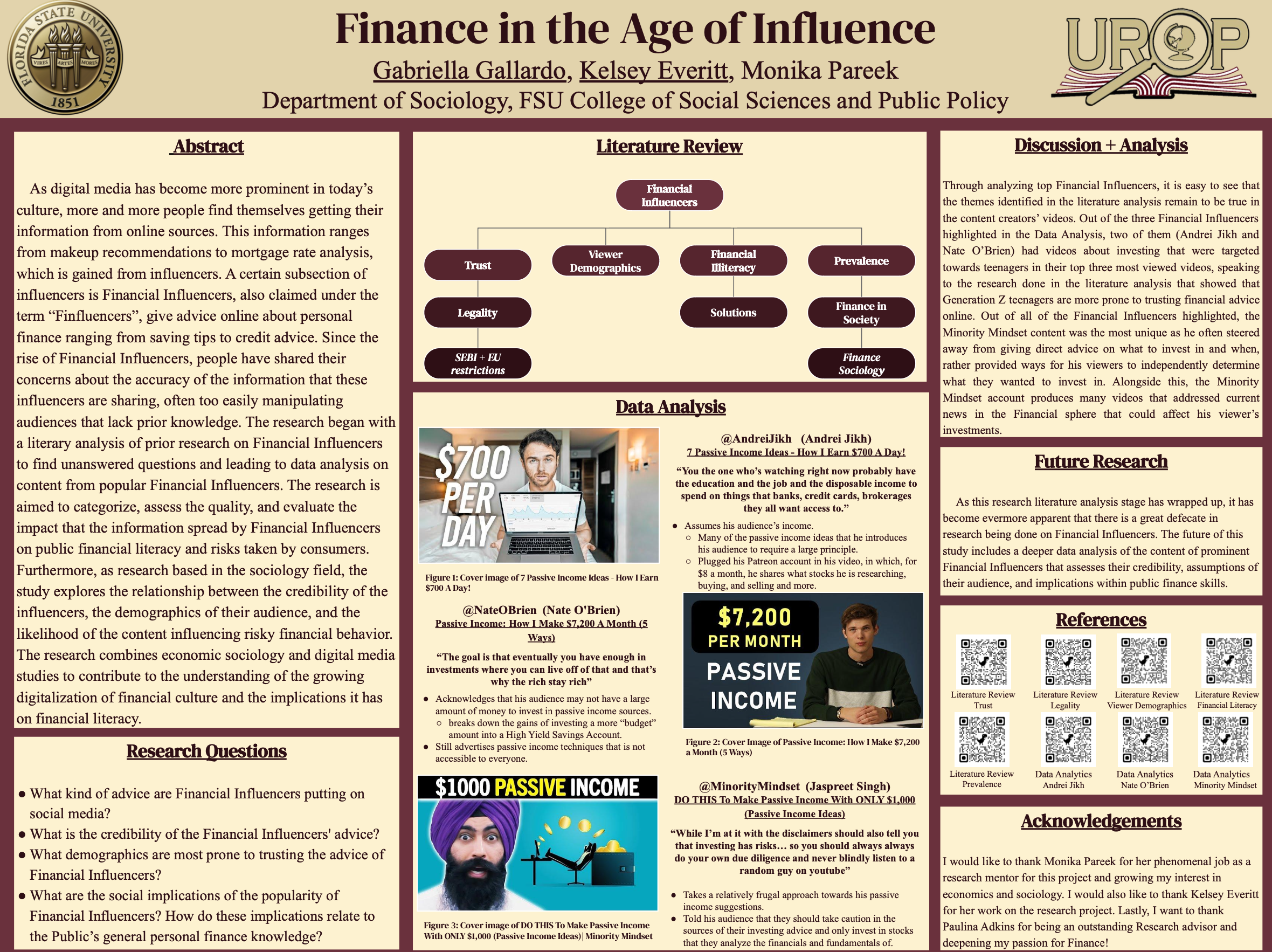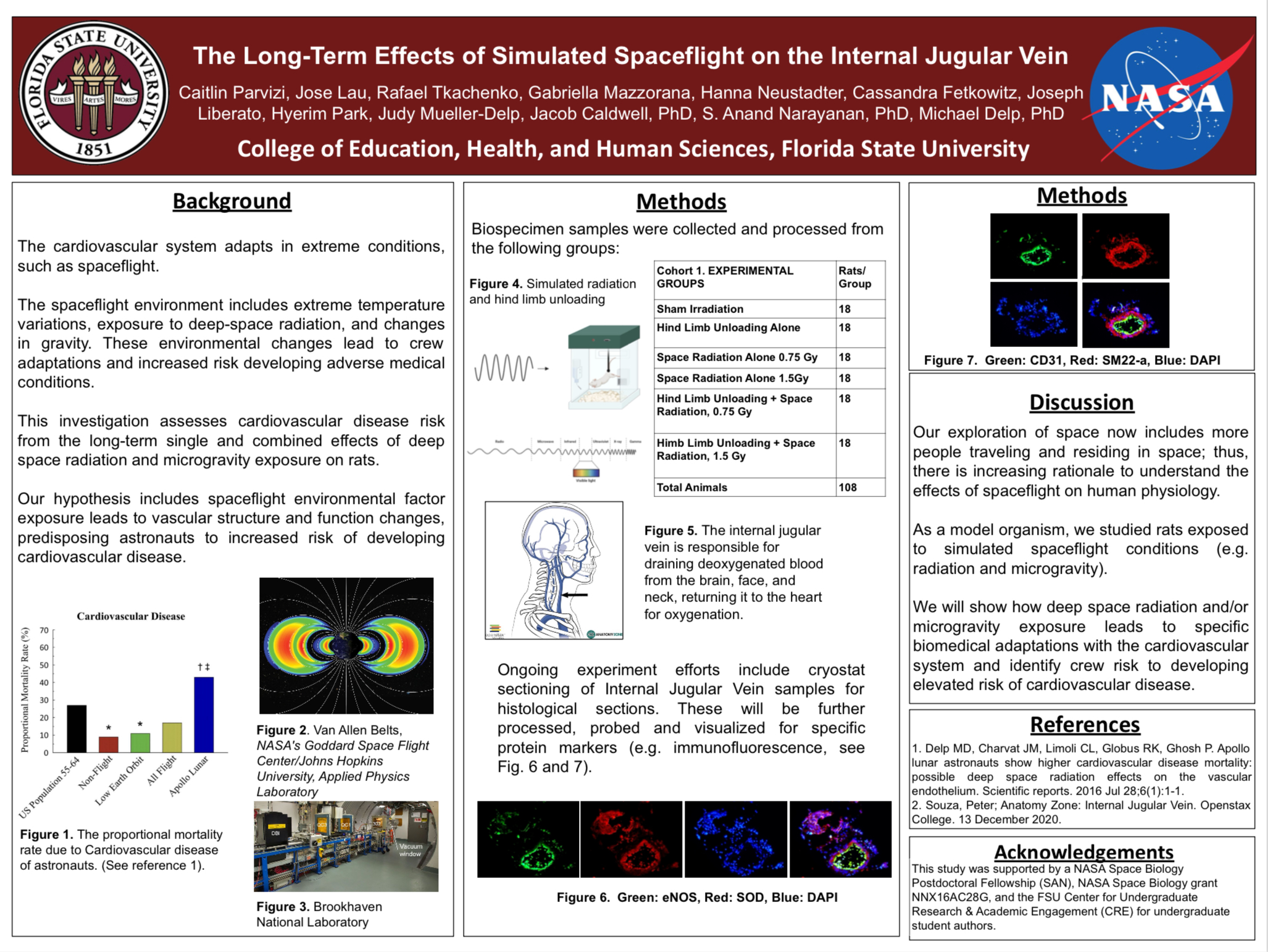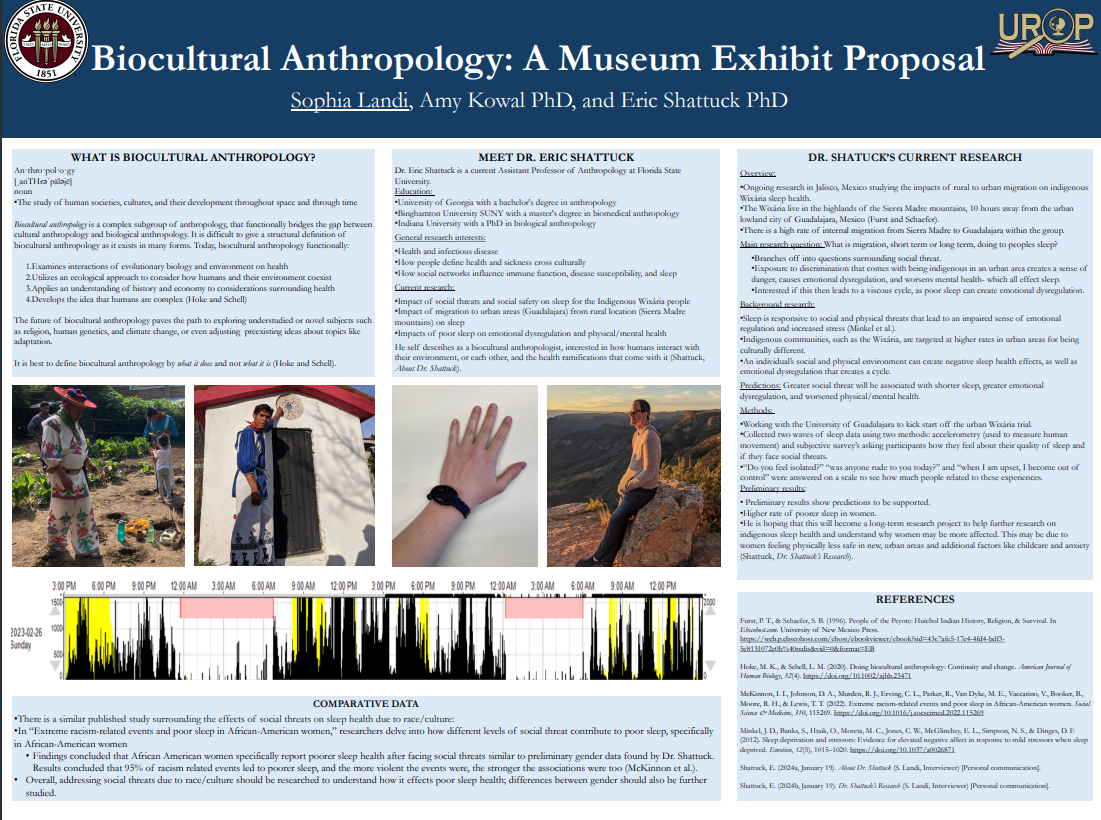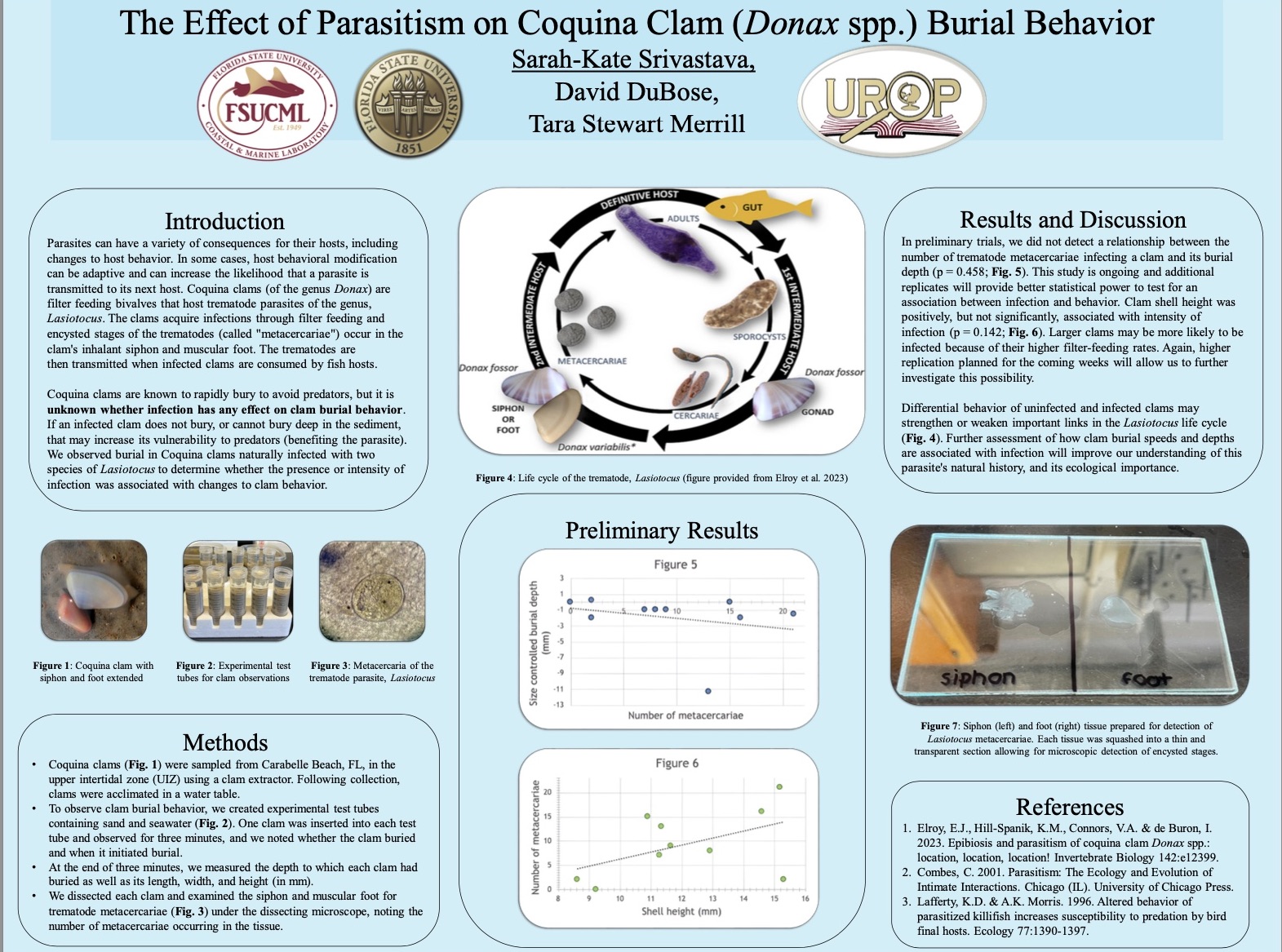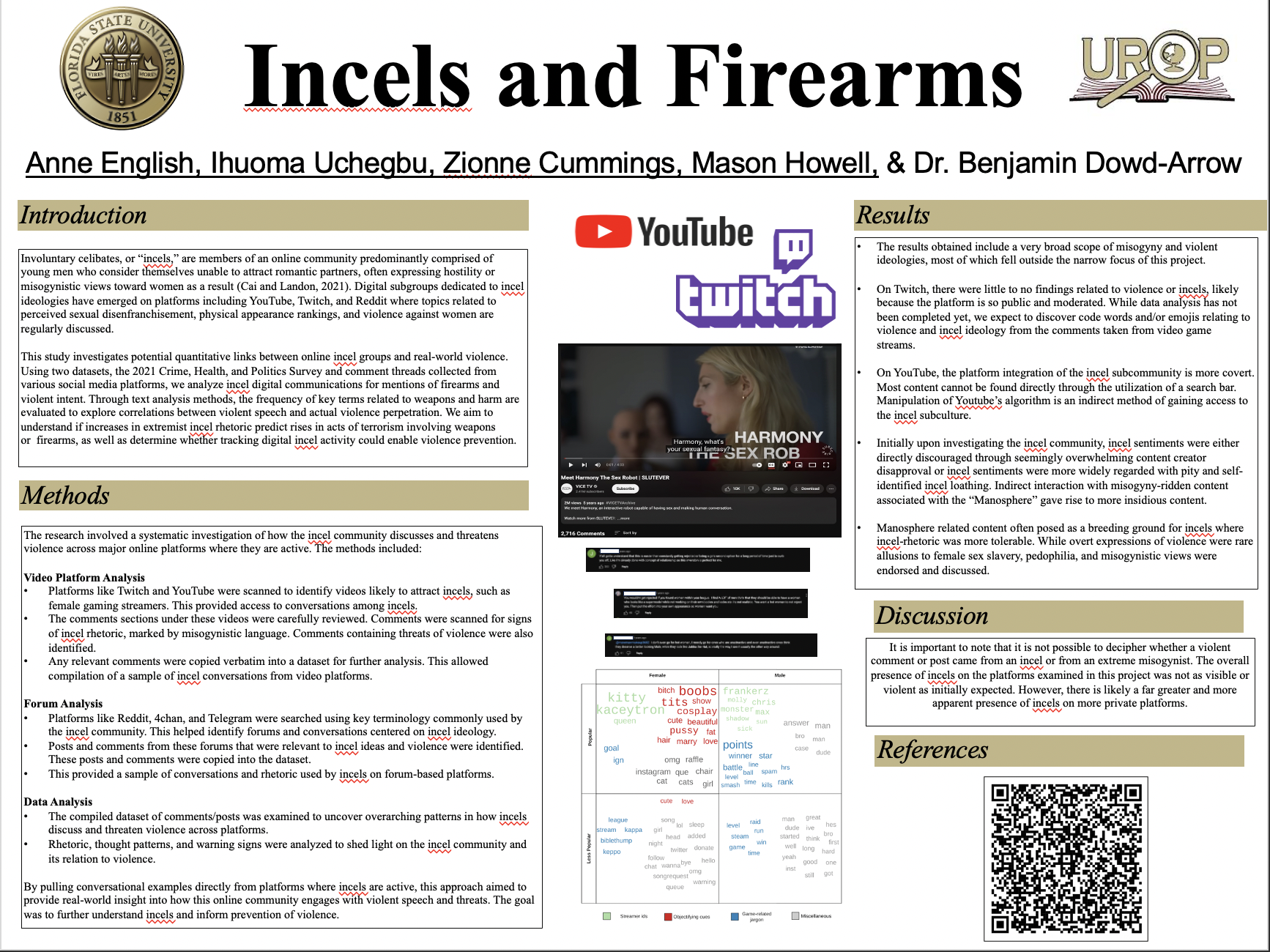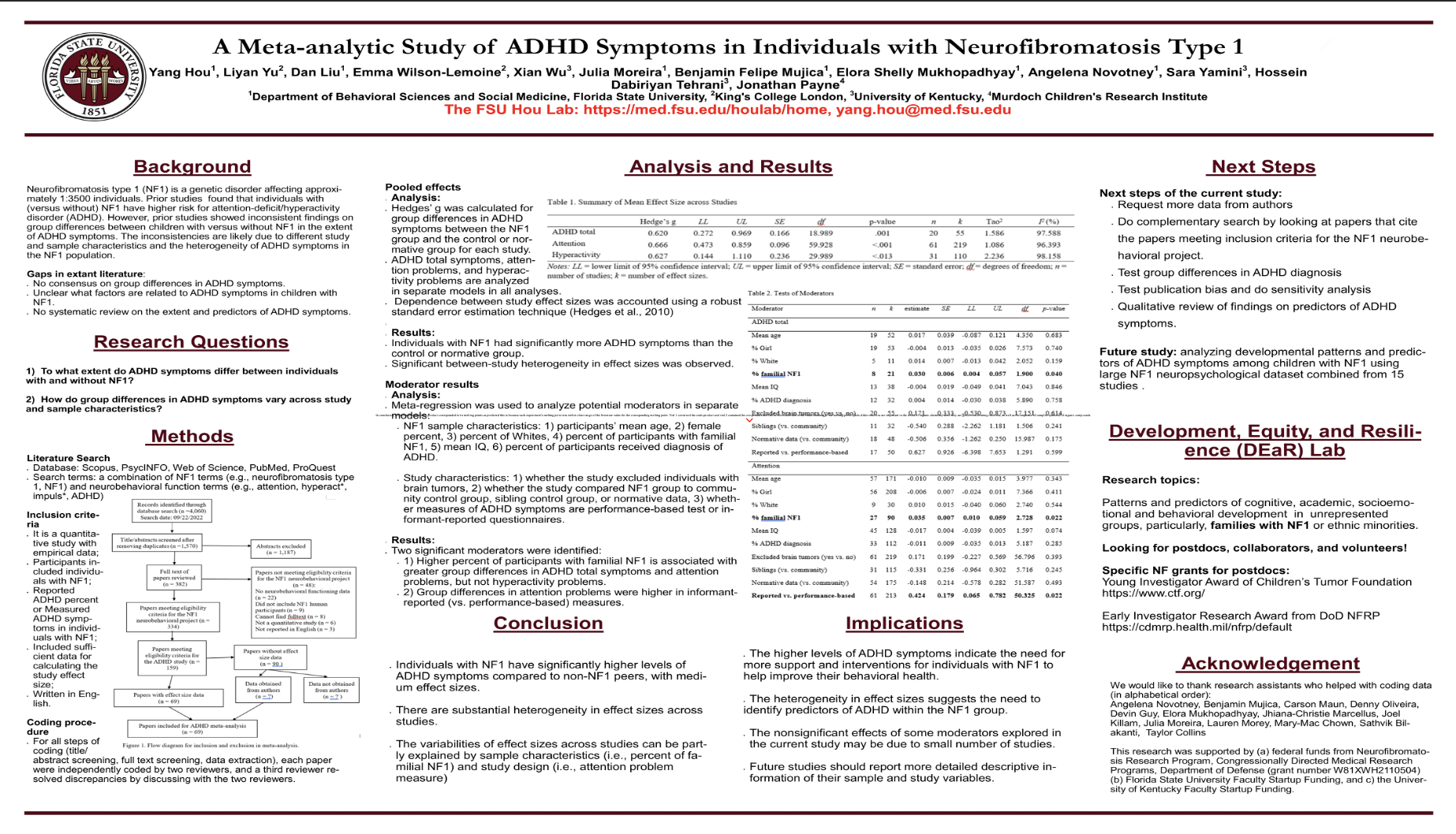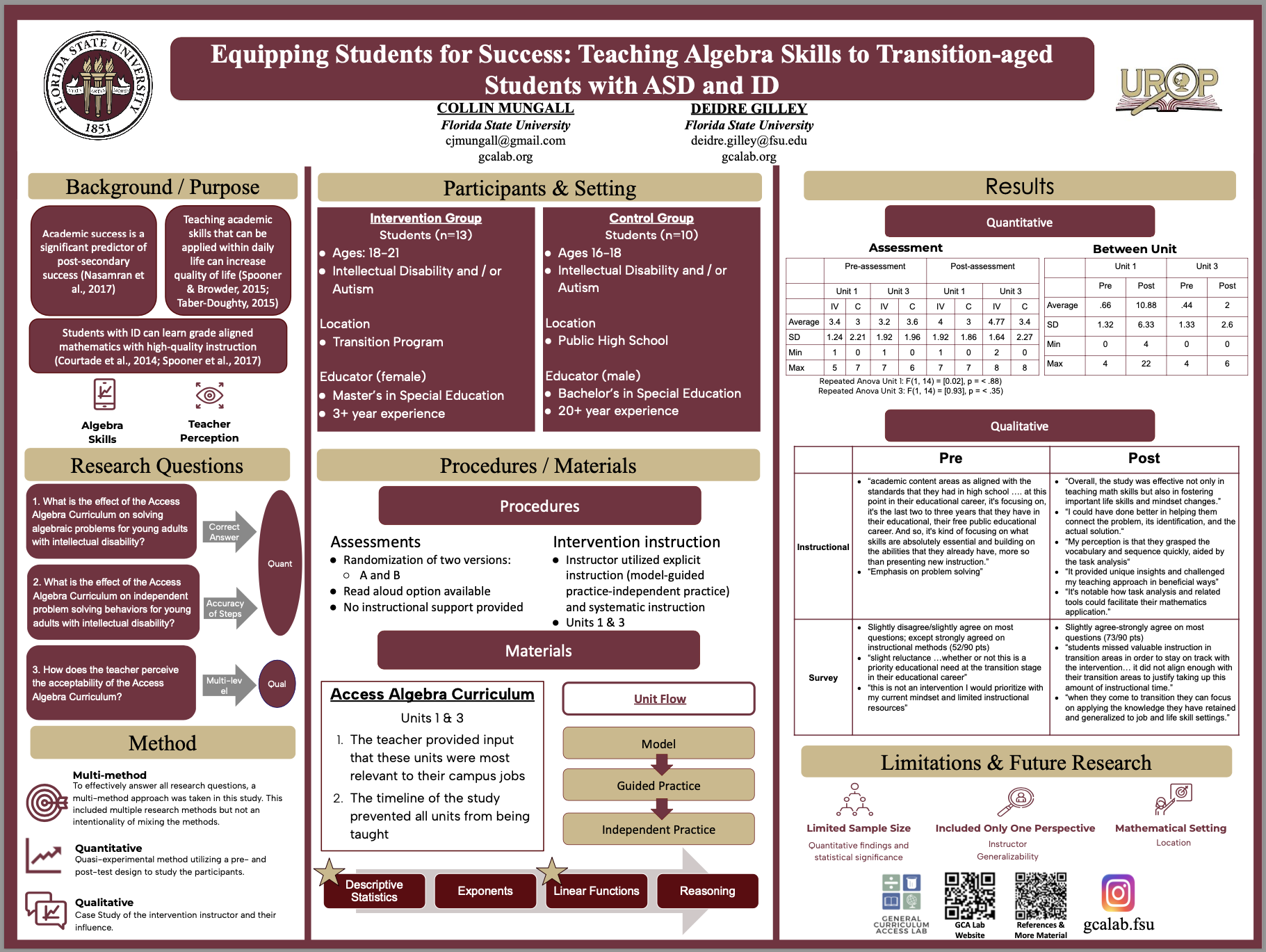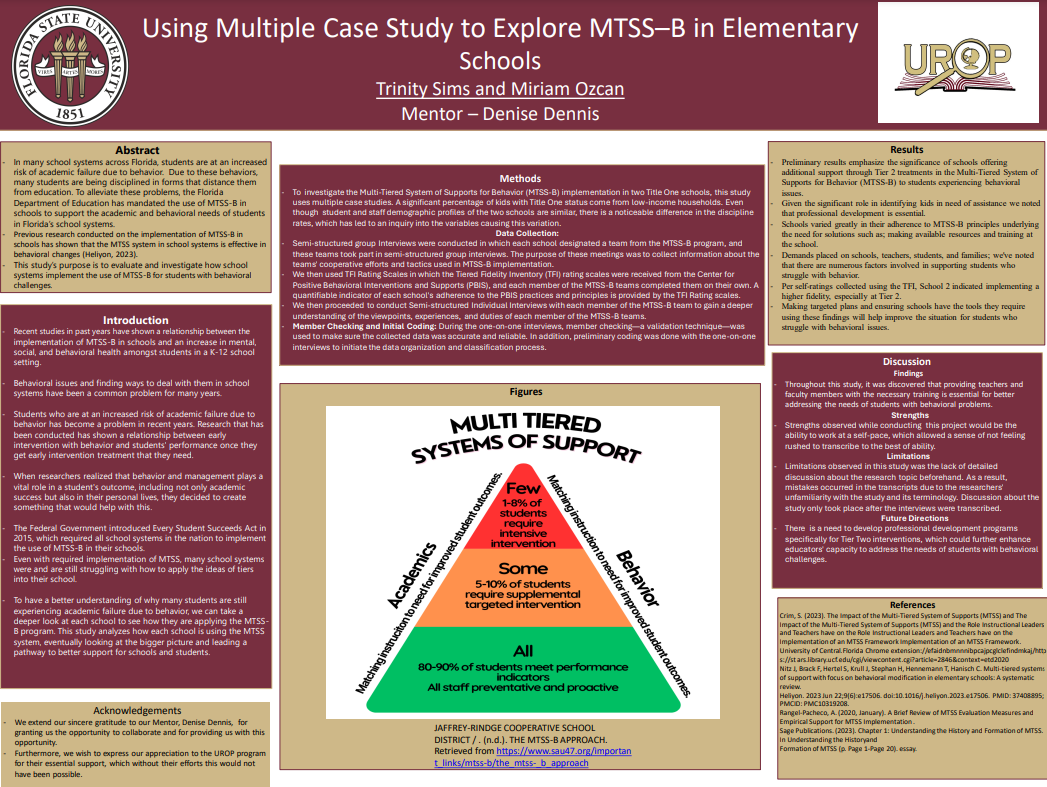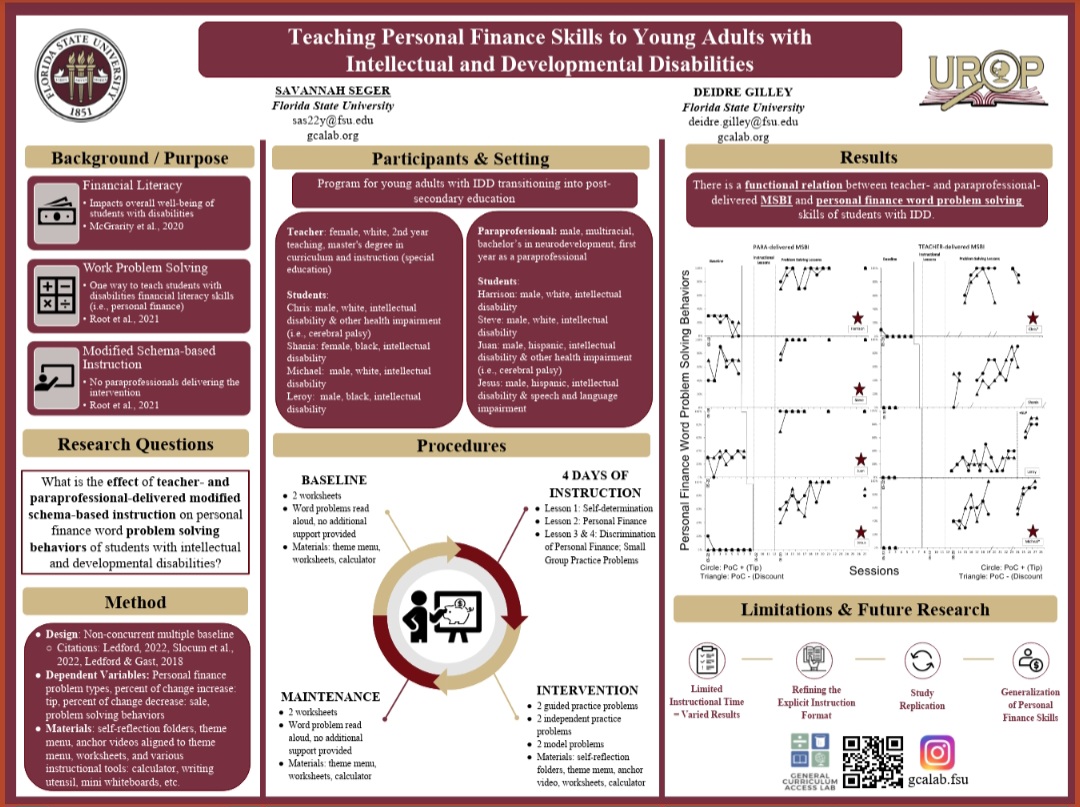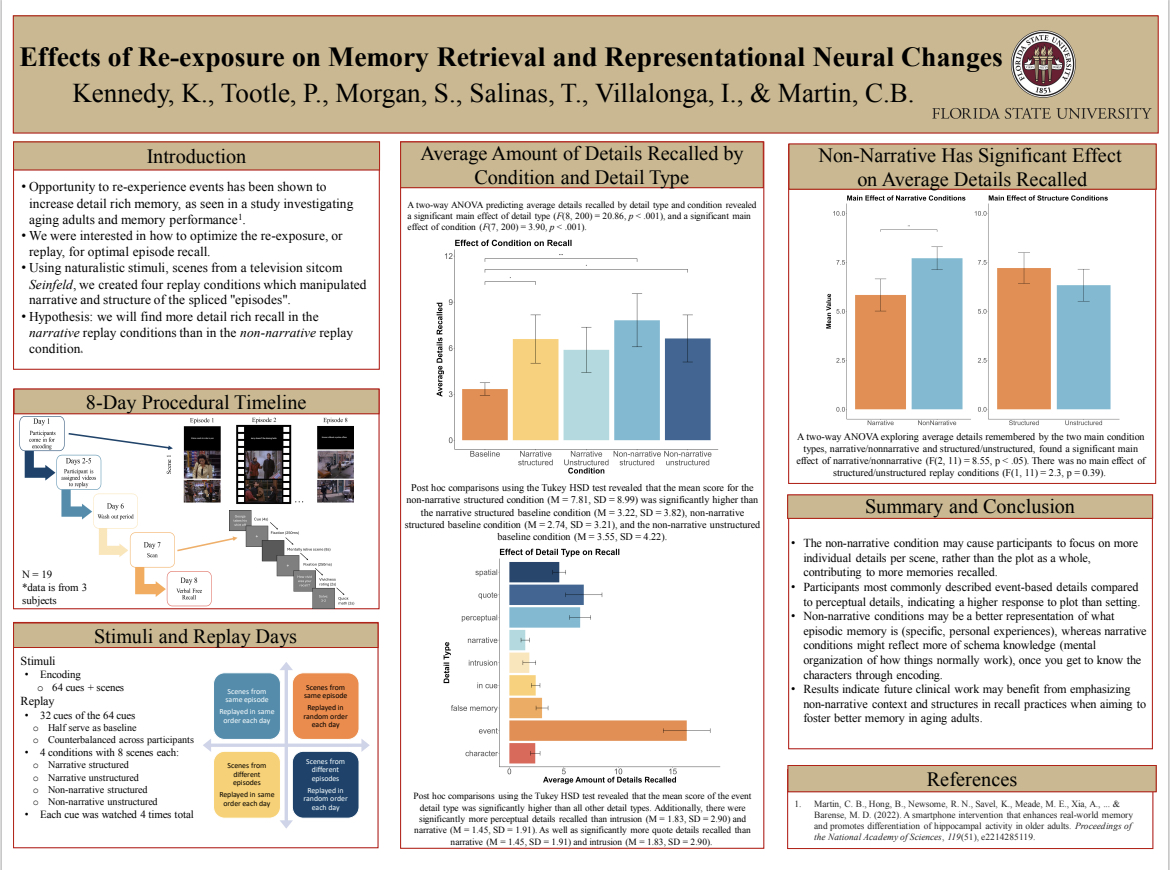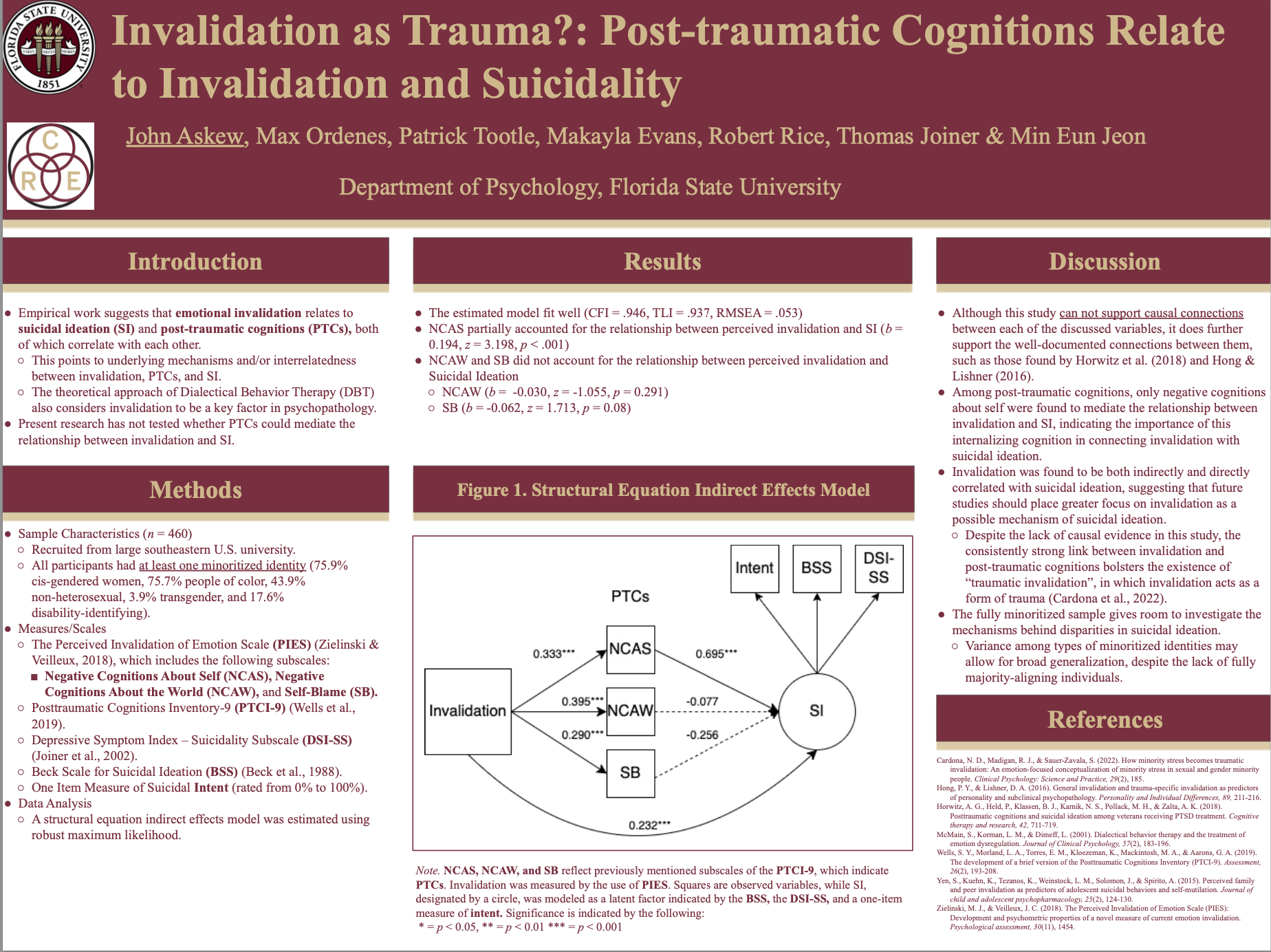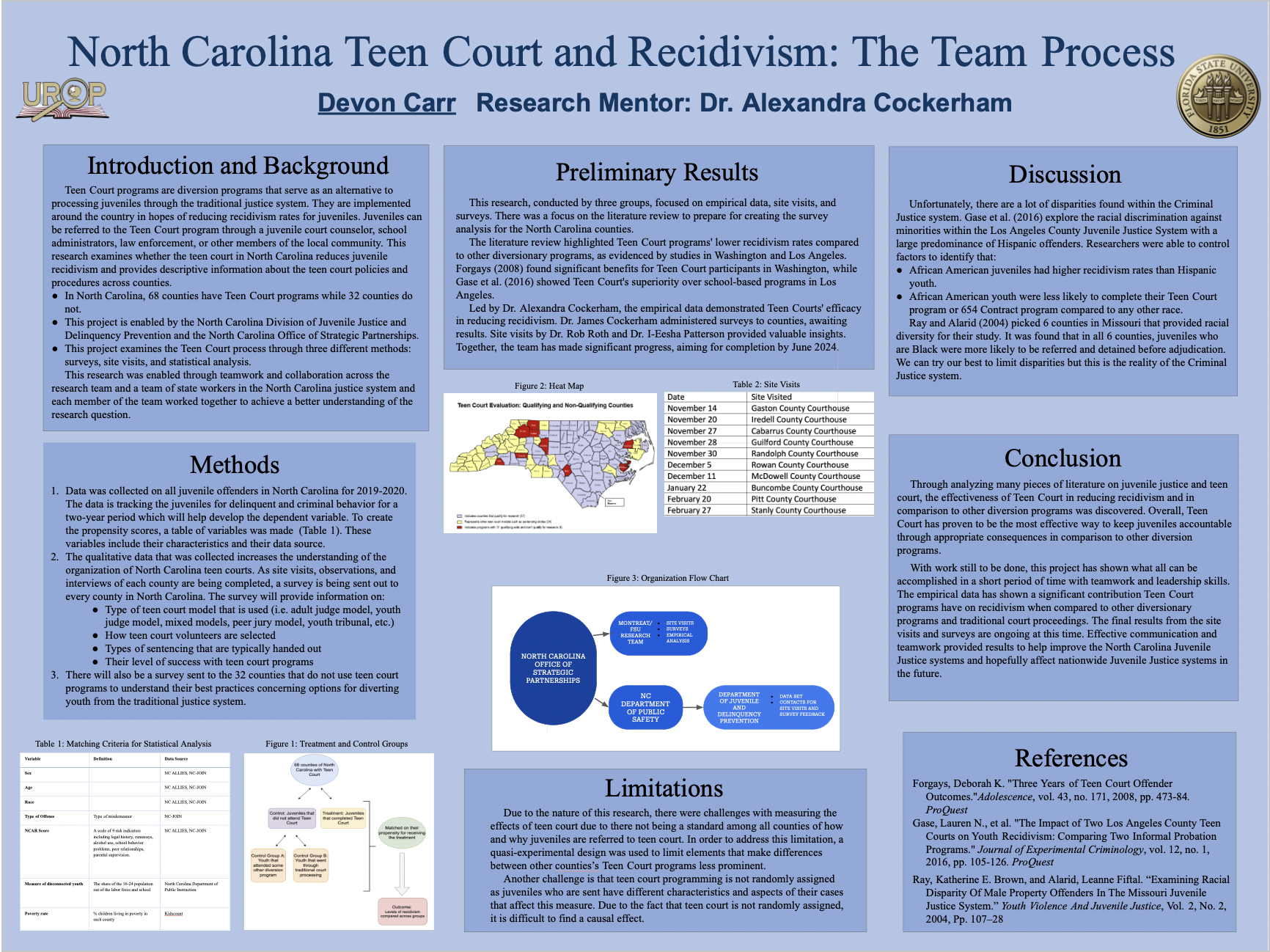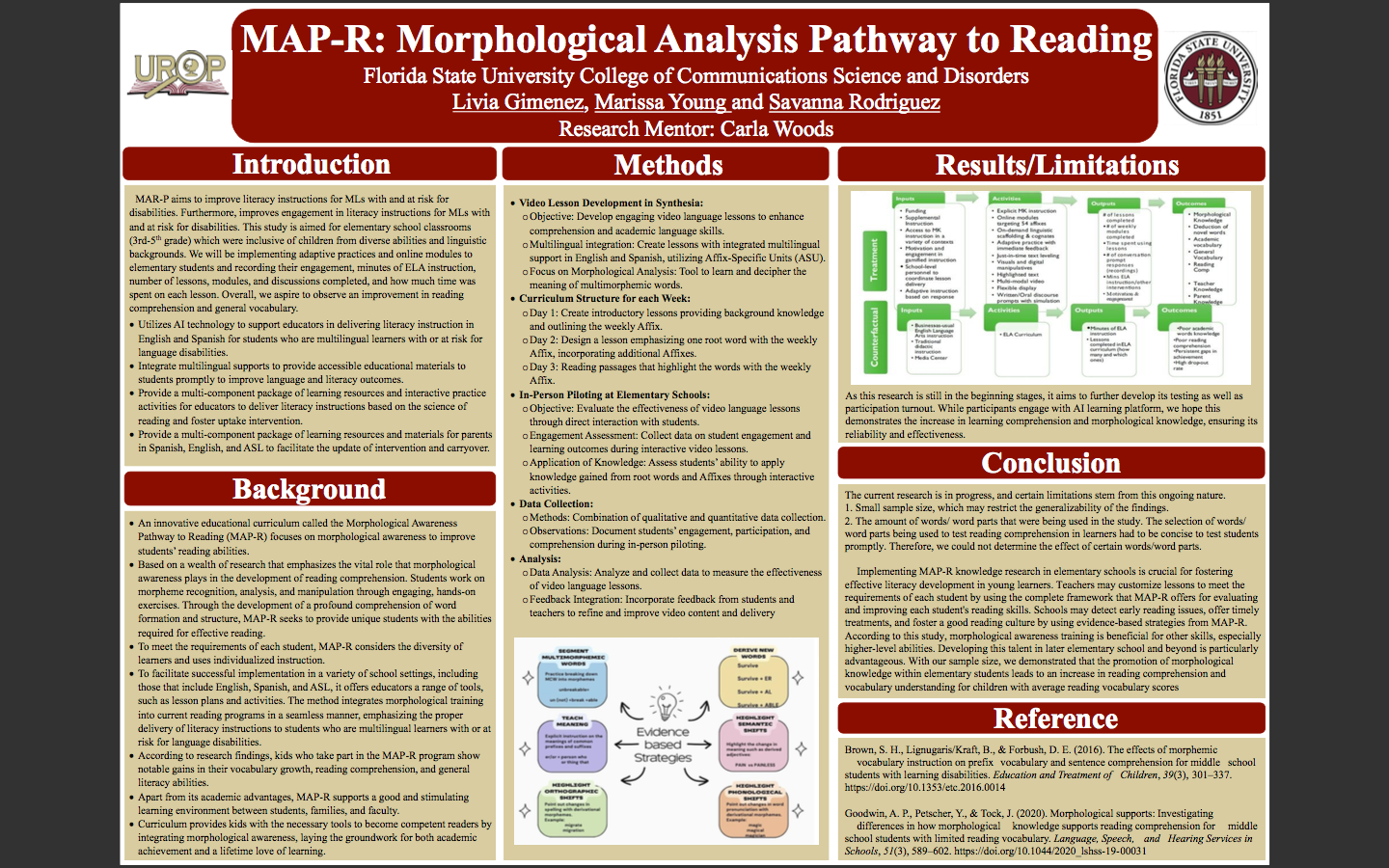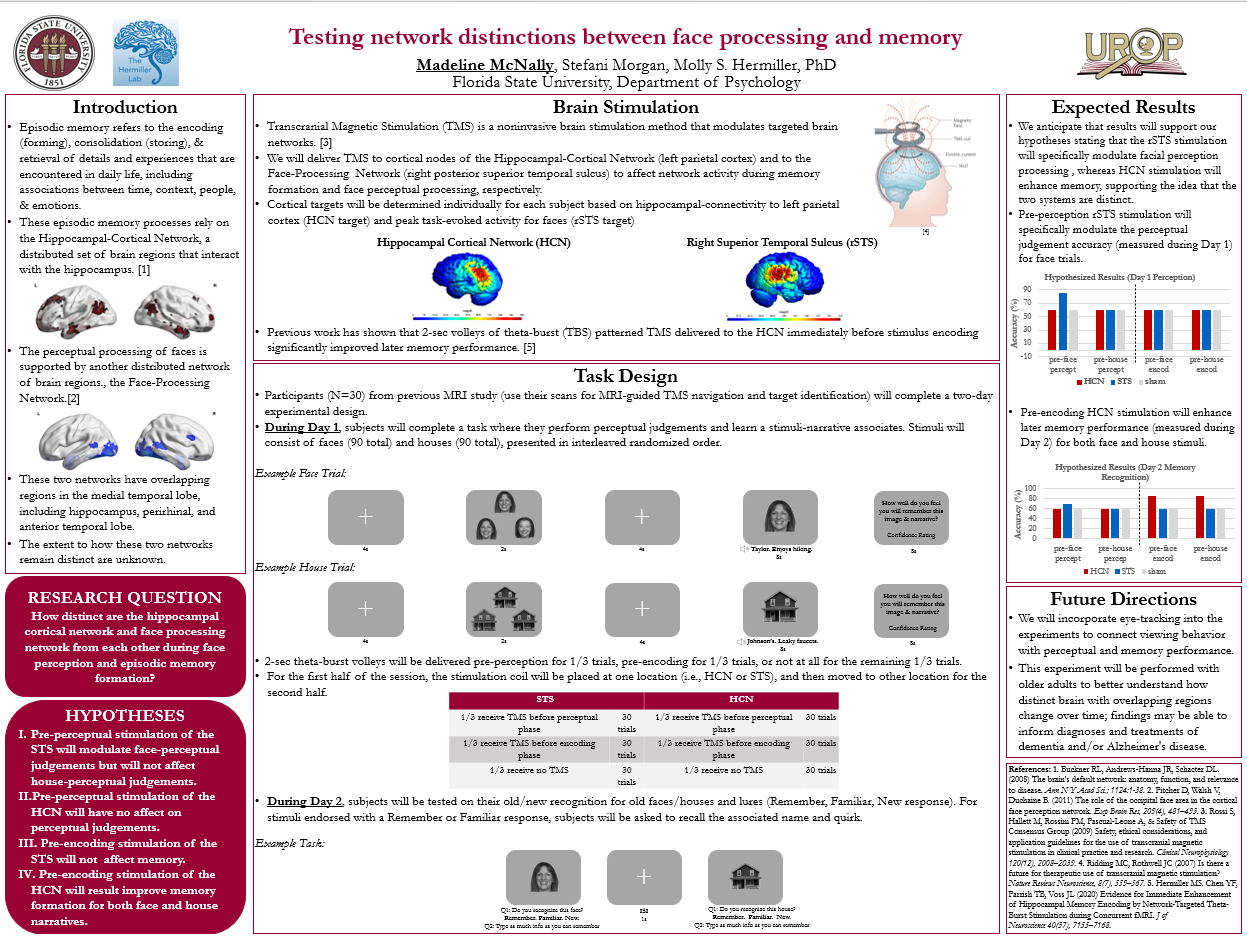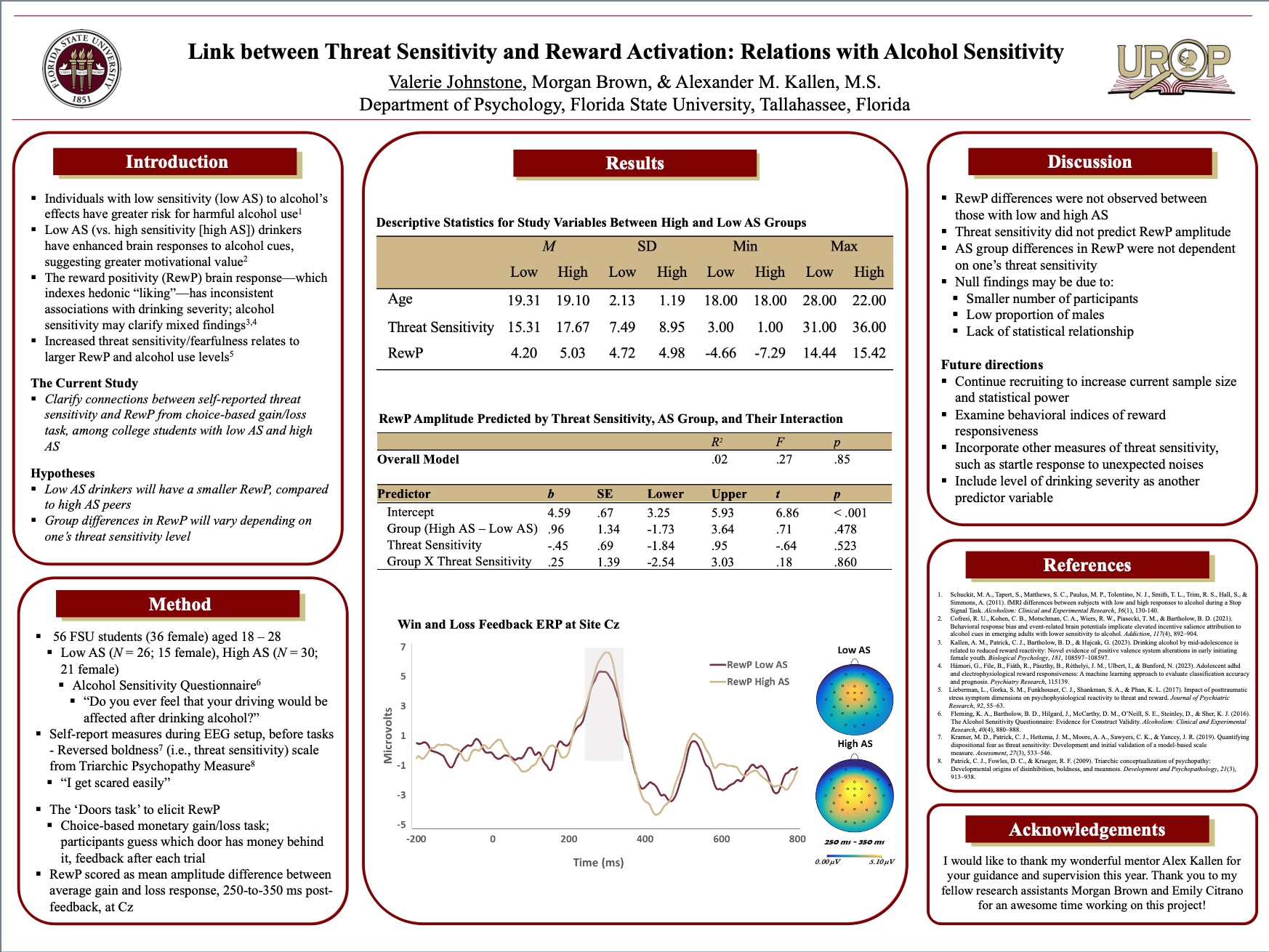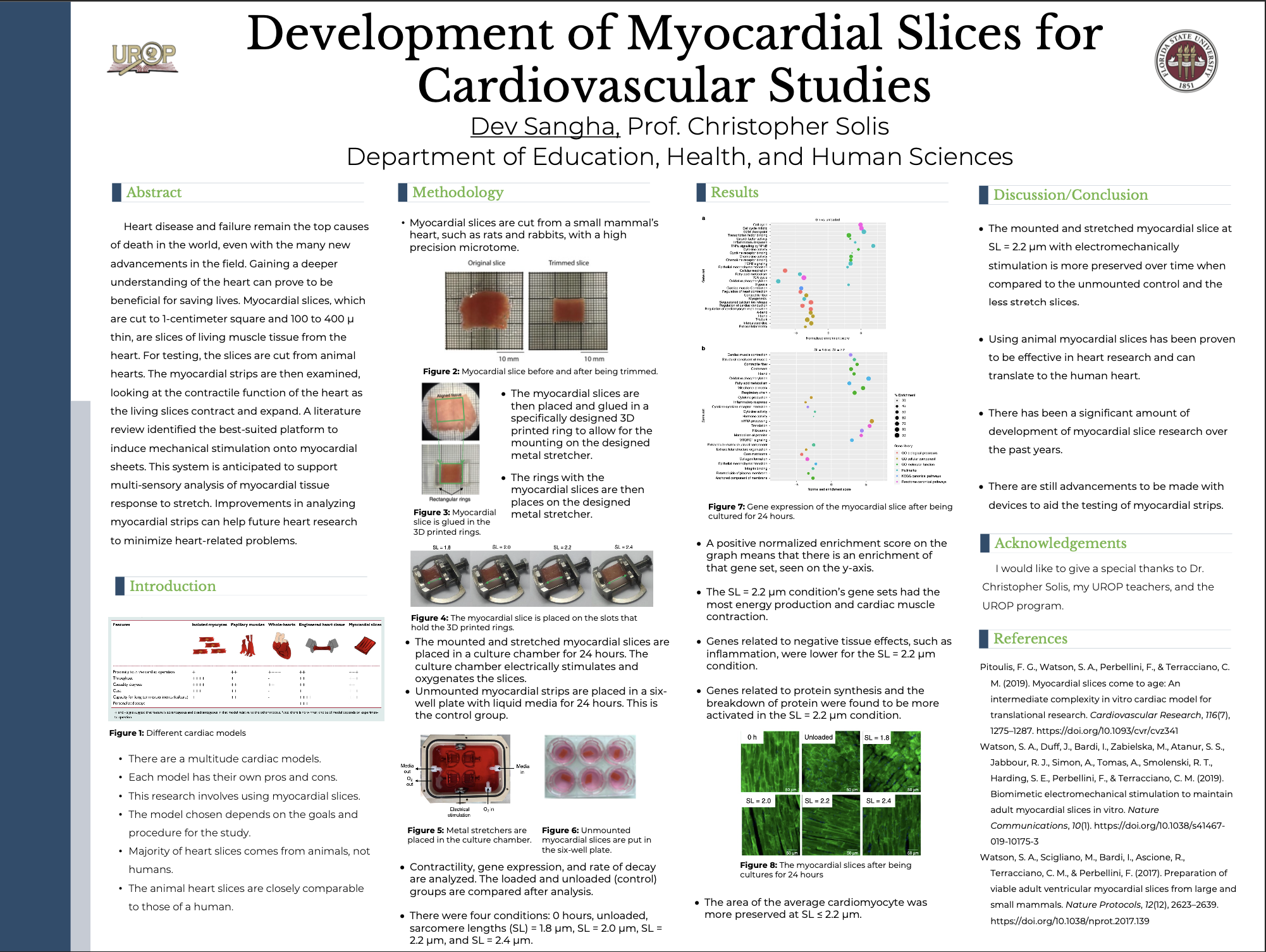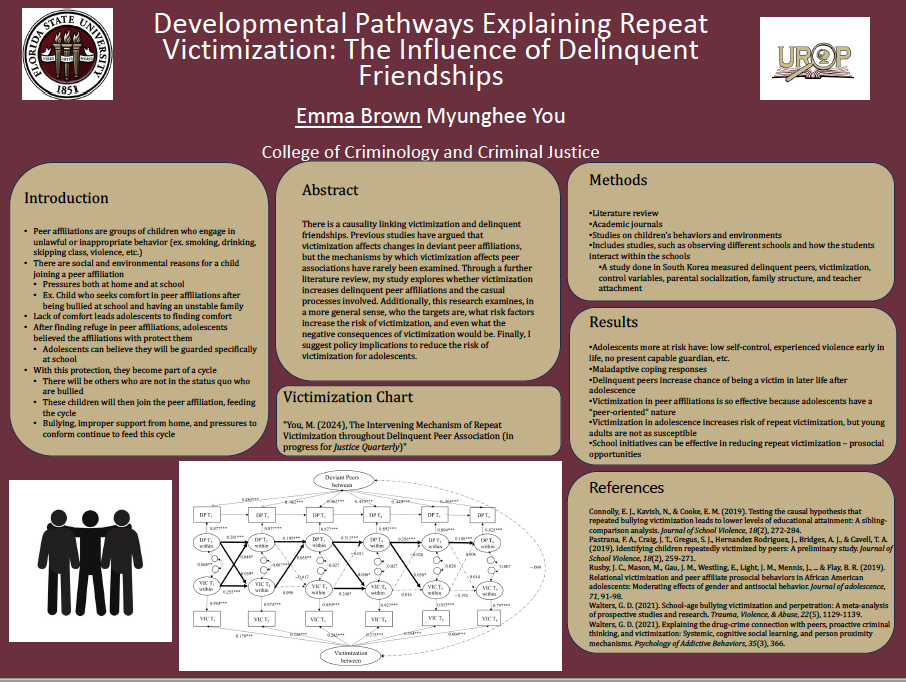Research Symposium
24th annual Undergraduate Research Symposium, April 3, 2024
Gabriella Gallardo Poster Session 4: 2:45 pm - 3:45 pm /70
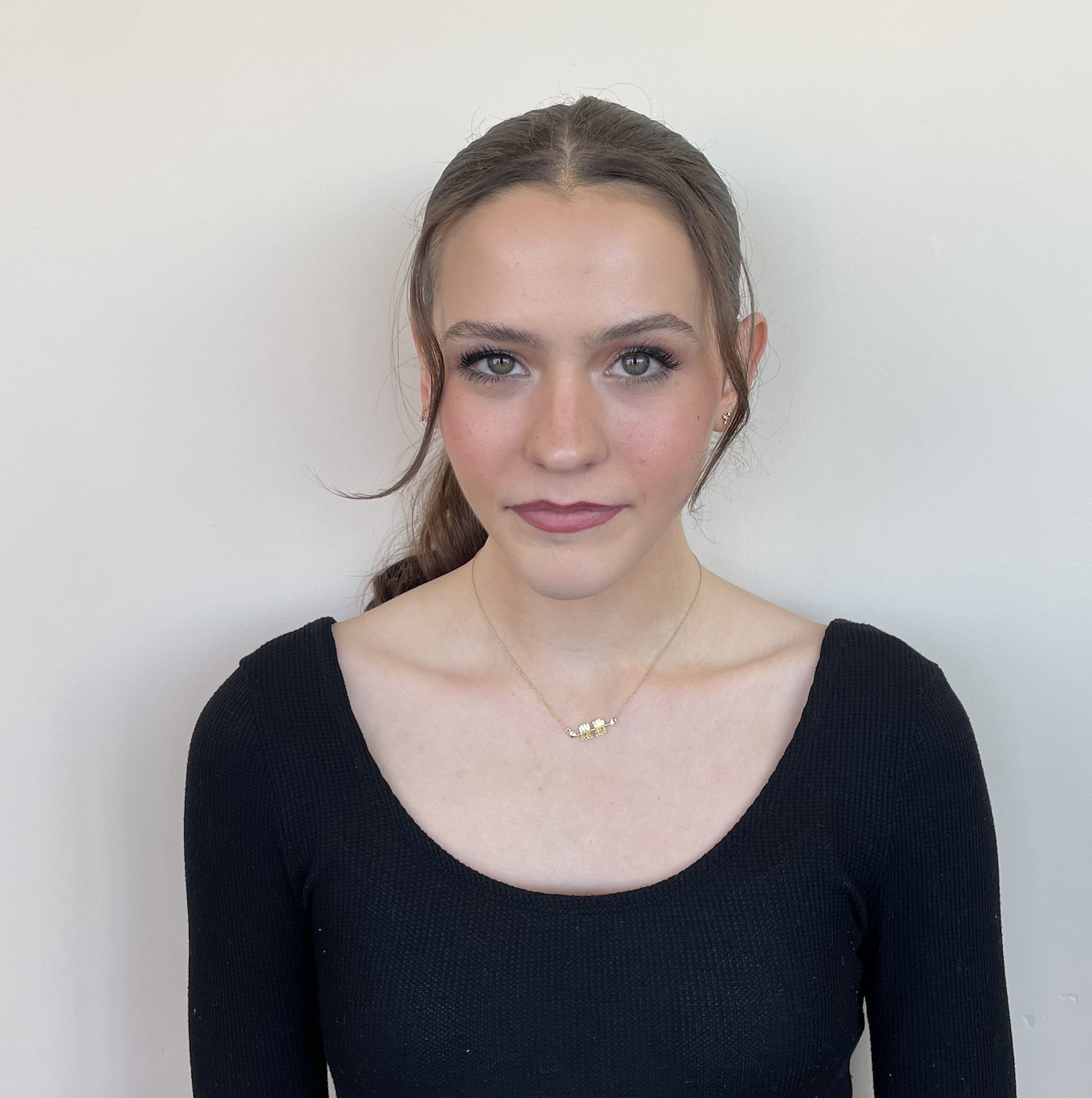
BIO
Gabriella Gallardo is a Finance major from Denver, Colorado. Gabriella has been conducting research under Monika Pareek with Kelsey Everitt to investigate Financial Influencers, aimed to categorize, assess the quality, and evaluate the impact that the information spread by Financial Influencers on public financial literacy and risks taken by consumers from a socioeconomic approach, focusing on race, gender, and age. Outside of her participation in the Undergraduate Research Opportunity Program, she serves as the Finance Chair of the Iota Rho chapter of Alpha Phi Omega, an annual giving trustee of the Student Foundation, and 2024 FSU Orientation Leader. Gabriella plans to continue her participation in research, in particular in the economic field. Gabriella's long-term career goal is to become a financial advisor with an emphasis on pro-bono advising.
Finance in the Age of Influence
Authors: Gabriella Gallardo, Monika PareekStudent Major: Finance
Mentor: Monika Pareek
Mentor's Department: Department of Sociology Mentor's College: FSU College of Social Sciences and Public Policy Co-Presenters:
Abstract
As digital media has become more prominent in today’s culture, more and more people find themselves getting their information from online sources. This information ranges from makeup recommendations to mortgage rate analysis, which is gained from influencers. A certain subsection of influencers is Financial Influencers, also claimed under the term “Finfluencers”, give advice online about personal finance ranging from saving tips to credit advice. Since the rise of Financial Influencers, people have shared their concerns about the accuracy of the information that these influencers are sharing, often too easily manipulating audiences that lack prior knowledge. The research began with a literary analysis of prior research on Financial Influencers to find unanswered questions and leading to data analysis on content from popular Financial Influencers. The research is aimed to categorize, assess the quality, and evaluate the impact that the information spread by Financial Influencers on public financial literacy and risks taken by consumers. Furthermore, as research based in the sociology field, the study explores the relationship between the credibility of the influencers, the demographics of their audience, and the likelihood of the content influencing risky financial behavior. The research combines economic sociology and digital media studies to contribute to the understanding of the growing digitalization of financial culture and the implications it has on financial literacy.
Keywords: Finance, Sociology, Economics, Influencers
24th annual Undergraduate Research Symposium, April 3, 2024
Caitlin Parvizi Poster Session 5: 4:00 pm - 5:00 pm/77

BIO
Caitlin Parvizi is a 3rd year Biochemistry major from Palm Harbor, Florida. Throughout her time at Florida State, Caitlin has been involved in various space-medicine related research projects under the direction of Dr. Narayanan, and is currently working on her Honors in the Major Thesis Project, titled "Spaceflight Effects of Lunar Gravity and Microgravity on Cardiovascular and Reproductive Physiology." Her career aspirations involve attending medical school to become a physician.
The Long-Term Effects of Simulated Spaceflight on the Internal Jugular Vein
Authors: Caitlin Parvizi, Sunny NarayananStudent Major: Biochemistry
Mentor: Sunny Narayanan
Mentor's Department: Department of Health, Nutrition, and Food Sciences Mentor's College: College of Education, Health & Human Sciences Co-Presenters:
Abstract
Astronauts' exposure to the unique spaceflight environment induces physiological adaptations, including affecting cardiovascular function. These adaptations occur due to microgravity and space radiation exposure. For example, the internal jugular vein (IJV), a major conduit for cerebral venous outflow, is involved with maintaining and regulating brain blood supply. Recent observations from spaceflight missions suggest the IJV is susceptible to spaceflight-induced adaptations. To investigate the mechanisms and specific effects of microgravity and radiation on the IJV, we conducted a study examining the long-term effects of single and combined simulated deep-space radiation and microgravity exposure on rats. Our study aimed to assess changes in IJV structure and function, as well as biochemical pathway alterations (e.g., endothelial nitric oxide synthase [eNOS] expression, oxidative stress) potentially caused by simulated spaceflight exposure. IJV samples were collected and processed for immunofluorescence protein analysis using cryostat sectioning. The findings from this study will contribute to our overall understanding of cardiovascular adaptations associated with spaceflight that are occurring with our astronauts, as well as provide insight for future countermeasure development to improve crew health outcomes during long-duration space missions.
Keywords: Space, cardiology, health, medicine
24th annual Undergraduate Research Symposium, April 3, 2024
Sophia Landi Poster Session 3: 1:30 pm - 2:30 pm /219
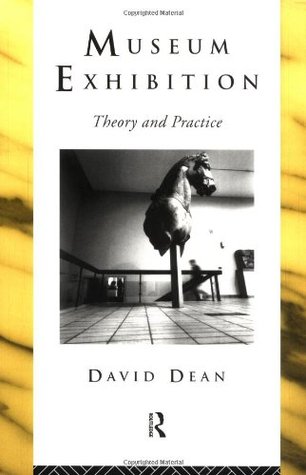
BIO
Hi everyone! My name is Sophia and I am a student at Florida State University, pursing a degree in Interdisciplinary Medical Studies: Pre-Clinical Professions. I am involved in UROP, and will be an upcoming learning assistant for General Chemistry I! I love to read, go to the movies, and hang out with my family.
Biocultural Anthropology: A Museum Exhibit Proposal
Authors: Sophia Landi, Amy KowalStudent Major: Interdisciplinary Medical Studies: Pre-Clinical Professions
Mentor: Amy Kowal
Mentor's Department: Department of Anthropology Mentor's College: College of Arts and Sciences Co-Presenters: N/A
Abstract
Museums serve communities across the world, small or large, as centers for learning. Florida State University houses an extremely unique course that delves into the specifics of curating museum exhibits based on research from professors within the anthropology department. Past exhibits include “Deconstructing Race,” “Panama Archeology,” and “Peopling of the America’s.” This project serves as a museum exhibit proposal to showcase the work of Dr. Eric Shattuck, a biocultural anthropologist, that will be developed in Fall of 2024. The exhibit will begin with an introduction to what biocultural anthropology is as it is a complex, interdisciplinary subject. The following section Dr. Shattuck, his educational background, and why he pursued the biocultural branch of anthropology will be briefed. The next portion of the exhibit will be centered around his research with the indigenous Wixárika in Jalisco, Mexico. Dr. Shattuck explores the effects of rural and urban location on sleep health within the community, and how social pressures placed on indigenous members to acclimate to urban areas may affect a good night's rest. The final portion of the exhibit will touch on comparative data from previous biocultural sleep research conducted within other cultural groups, such as African Americans.
Keywords: museum, anthropology, cultural
24th annual Undergraduate Research Symposium, April 3, 2024
Sarah Kate Srivastava Poster Session 2: 10:45 am - 11:45 am/308
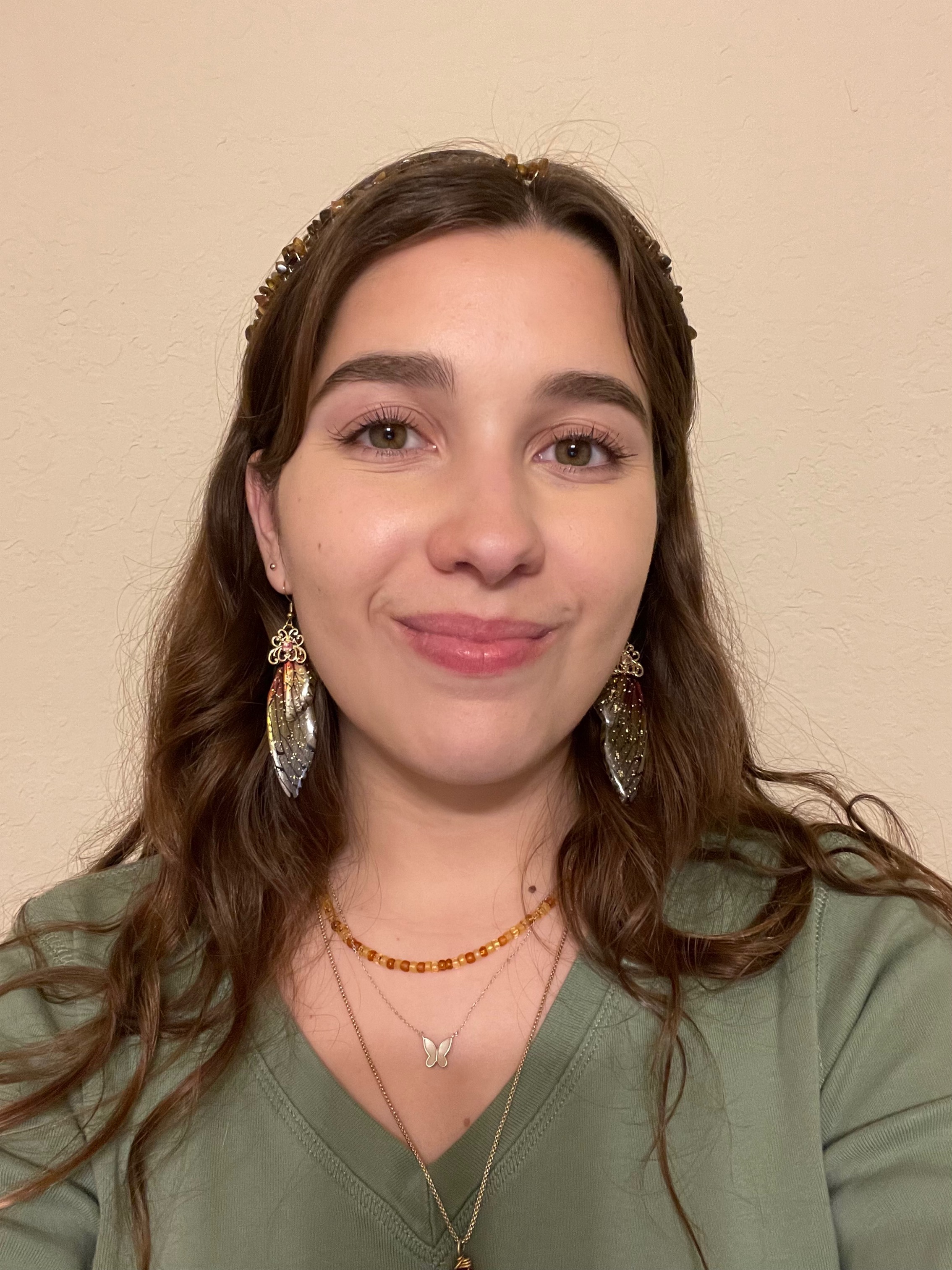
BIO
My name is Sarah-Kate Srivastava and I am currently pursuing a career in marine biology. Experimental design and research have always been an interest of mine, so I am thankful for the opportunity to be involved in the RAD lab. I have a pet bunny who loves bananas and two other siblings. During my free time, I enjoy going to state parks with friends such as the Florida Caverns or Falling Waters State Park.
The Effect of Parasitism on Coquina Clam (Donax spp.) Burial Behavior
Authors: Sarah Kate Srivastava , Dr. Tara Stewart-MerrillStudent Major: Biology
Mentor: Dr. Tara Stewart-Merrill
Mentor's Department: Coastal and Marine Laboratory Mentor's College: Office of Research Co-Presenters: N/A
Abstract
Coquina clams are known to carry the parasites Lasiotocus trachinoti and L. choanura. The former can be found in the organism's inhalant siphon, while the latter can be found in the muscular foot. What is unknown is whether these parasites have any effect on their behavior. To investigate this, 50 clams were collected from the upper intertidal zone (IUZ), studied, and then dissected. Clams of all sizes were chosen and measured to obtain sufficient data because larger clams are more likely to be parasitized. The clams were individually placed into tubes filled with sand and seawater, then observed for three minutes. At the end of the three minutes, the depth at which they had dug was measured and recorded, along with the initial digging time. They were then dissected and examined for the presence or absence of parasites, which were subsequently quantified.
Keywords: Parasites, Bivalves, Behavior
24th annual Undergraduate Research Symposium, April 3, 2024
Ihuoma Uchegbu Poster Session 3: 1:30 pm - 2:30 pm /258

BIO
As a student at Florida State University majoring in Biochemistry, I am deeply passionate about pursuing a career in medical research. I recognize the immense potential of scientific exploration to unravel the mysteries of life and address complex challenges facing humanity. My interests lie at the intersection of biology, chemistry, health, and social behaviors. I am actively seeking opportunities to contribute my enthusiasm and diverse skillset to impactful research projects aligned with my interests. My ultimate goal is to advance scientific understanding and make meaningful contributions through my research endeavors
Incels and Firearms
Authors: Ihuoma Uchegbu, Benjamin Dowd-ArrowStudent Major: Biochemistry
Mentor: Benjamin Dowd-Arrow
Mentor's Department: Public Health Mentor's College: Social Sciences and Public Policy Co-Presenters: Zionne Cummings, Anne English, Mason Howell
Abstract
This study addresses violent tendencies against women among heterosexual male involuntary celibates, also known as ‘incels.’ The aim of this study is to determine the extent to which incels use online platforms and discourse communities to voice their opinions as well as the degree to which other members of the community agree or disagree with each other. The research employed online text analysis methods to pull discourse from online platforms including Reddit, YouTube, Twitch, and Telegram. The researchers conducted an analysis of the pulled comments and posts to search for common key words and opinions. While analysis of raw data is still ongoing, current findings suggest that incels prefer to discuss their ideologies on more private platforms and tend to use code words for violent ideals on more public platforms.
Keywords: incel, Reddit, violence, masculinity
24th annual Undergraduate Research Symposium, April 3, 2024
Angelena Novotney Poster Session 4: 2:45 pm - 3:45 pm /64

BIO
Angelena Novotney is a sophomore pursuing a bachelor’s degree in Biology as well as a bachelor’s degree in Philosophy within the Florida State University College of Arts and Sciences. Her career goals include attending medical school to study Ophthalmology with a retinal specialty and opening her own private practice. She is currently a CCMA at Tallahassee Memorial Hospital, an executive board member of the Asian American Student Union, and an active member of her community by volunteering abroad to help provide healthcare to those in need.
A Meta-Analytic Study of ADHD Symptoms in Individuals with Neurofibromatosis Type 1
Authors: Angelena Novotney, Yang HouStudent Major: Biological Science and Philosophy
Mentor: Yang Hou
Mentor's Department: Behavioral Science and Social Medicine Mentor's College: Florida State University Co-Presenters:
Abstract
Neurofibromatosis type 1 (NF1) is a common genetic neurodevelopmental disorder affecting approximately 1:3500 individuals. Prior studies found that children with (versus without) NF1 have higher risk for attention deficit hyperactivity disorder (ADHD). However, prior studies showed inconsistent findings on group differences between children with versus without NF1 in the extent of ADHD symptoms. The inconsistencies are likely due to different study and sample characteristics and the heterogeneity of ADHD symptoms in the NF1 population. To evaluate this our lab performed a meta-analysis on current research in this field. Groups of two research assistants coded this information and met once a week to discuss differences found and form a consensus on the information presented. We found Individuals with NF1 had significantly more ADHD symptoms than the control or normative group. Significant between-study heterogeneity in effect sizes was observed. Additionally, a higher percentage of participants with familial NF1 is associated with greater group differences in ADHD total symptoms and attention greater group differences in ADHD total symptoms and attention problems, but not hyperactivity problems. Group differences in attention problems were higher in informant-reported (vs. performance-based) measures. From this, we concluded that children with NF1 have significantly higher levels of ADHD symptoms compared to non-NF1 peers, with medium effect sizes. This in context means that the higher levels of ADHD symptoms indicate the need for more support and interventions for children with NF1 to help improve their behavioral health.
Keywords: NF1 Neurofibromas ADHD attention
24th annual Undergraduate Research Symposium, April 3, 2024
Collin Mungall Poster Session 4: 2:45 pm - 3:45 pm /124

BIO
As a freshman at Florida State University, Collin is pursuing majors in both Management Information Systems and Finance. His passion for aiding those with intellectual disabilities drives his research endeavors. With an eye on a future in business management, he aims to leverage his degrees to enact positive change. At FSU, he is currently involved with Presidential Scholars, the Honors Program, the Financial Management Association, the Best Buddies Club, and the Sigma Phi Epsilon Fraternity. Committed to personal growth and societal impact, he embraces each opportunity to learn and lead, shaping a future marked by innovation and compassion.
Equipping Students for Success: Teaching Algebra Skills to Transition-aged Students with ASD and ID
Authors: Collin Mungall, Deidre GilleyStudent Major: Management Information Systems & Finance
Mentor: Deidre Gilley
Mentor's Department: College of Education Mentor's College: Florida State University Co-Presenters:
Abstract
Those with Intellectual Disorders (ID) have consistently struggled to develop sufficient math skills from standard curriculums. This has shown that without changes to their learning environments or methods, those with ID see significantly less growth in their math skillset than the non-disabled. Previous research has focused on finding ways to improve math understanding and retention for those with ID through a variety of methods. Whether it was changing the environment, testing processes, or something else, most research has yielded positive results. However, there hasn’t been enough success in implementing the results to make a genuine impact. This study attempted to address this with three main purposes: (a) to evaluate the effectiveness of the algebra curriculum, Access Algebra, for students with ID; (b) to explore how the instructor perceived the content to teach the students; and (c) to assess the applicability of the curriculum for the ID community as a whole. This study used a quantitative quasi-experimental pre and post-test design to determine the success of the Access Algebra curriculum. It also used a qualitative case study to explore the instructor's perception of the curriculum and the students’ abilities to understand it. Results have shown that the curriculum is more effective in teaching algebra to students with ID than the control group. The results also show that the instructor believes in the applicability of the curriculum. Our findings support wider implementation of this curriculum or other similar programs to progress the growth of math skills within the ID community.
Keywords: Algebra, Disabilities, Instruction, Autism
24th annual Undergraduate Research Symposium, April 3, 2024
Miriam Ozcan Poster Session 1: 9:30 am - 10:30 am /199
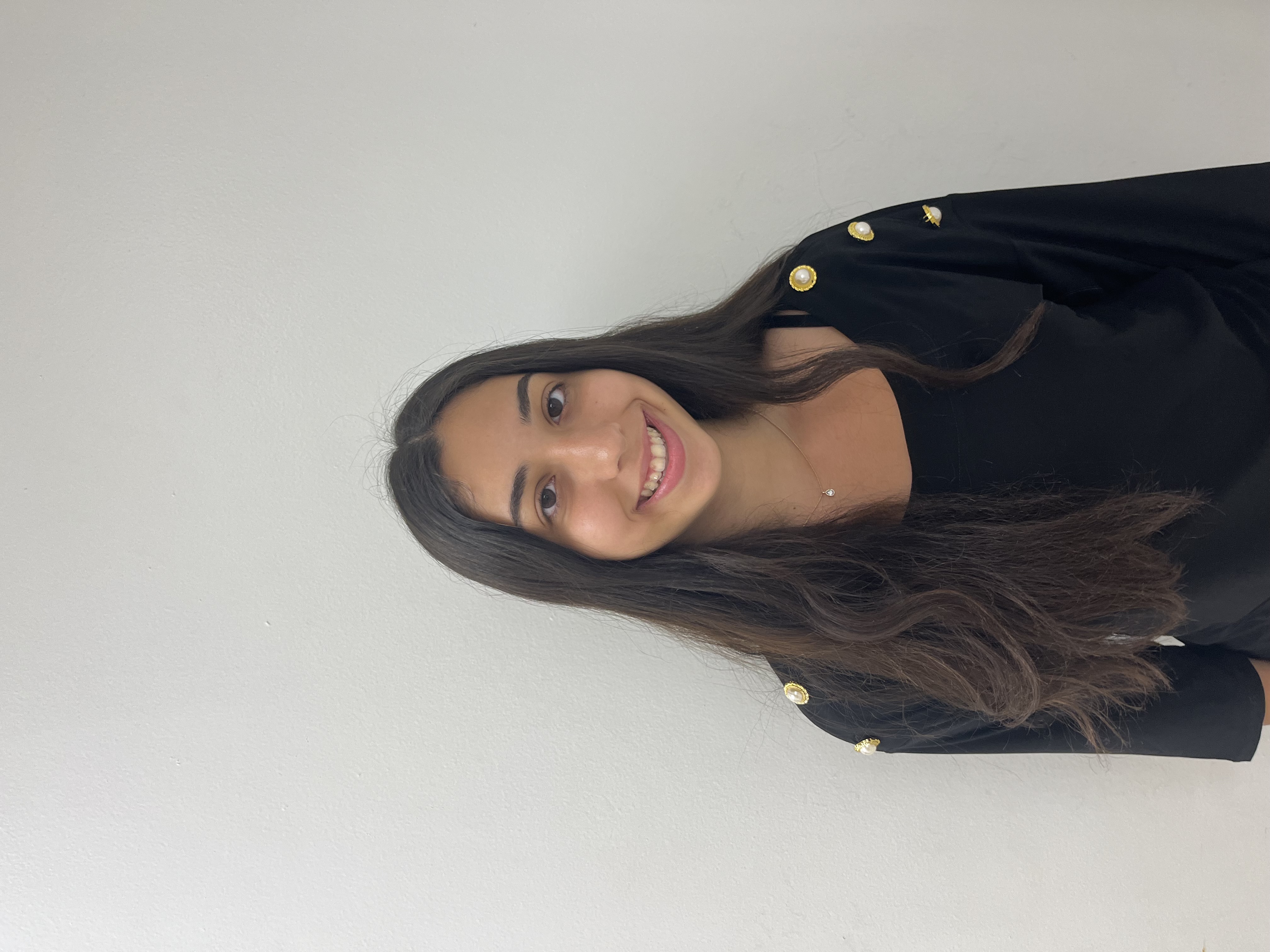
BIO
Hello, my name is Miriam and I am from Fort Lauderdale, Florida. I am currently majoring in Public Health and I plan to go into nursing school by next Spring. I am interested in research related to education and healthcare.
Using Multiple Case Study to Explore MTSS–B in Elementary Schools
Authors: Miriam Ozcan, Denise DennisStudent Major: Public Health
Mentor: Denise Dennis
Mentor's Department: Special Education Mentor's College: Education Co-Presenters: Trinity Sims
Abstract
In many school systems across Florida, students are at an increased risk of academic failure due to behavior. Due to these behaviors, many students are being disciplined in forms that distance them from education. To alleviate these problems, the Florida Department of Education has mandated the use of MTSS-B in schools to support the academic and behavioral needs of students in Florida’s school systems. Previous research conducted on the implementation of MTSS-B in schools has shown that the MTSS system in school systems is effective in behavioral changes (Heliyon, 2023). This study’s purpose is to evaluate and investigate how school systems implement the use of MTSS-B for students with behavioral challenges.
Keywords: MTSS, tiers, school, elementary
24th annual Undergraduate Research Symposium, April 3, 2024
Vayeira Moshe Poster Session 2: 10:45 am - 11:45 am/236

BIO
I am a 3rd year History student. I went to high school in Navarre, Florida. I am most interested in developing nation states in the modern period and the ways in which they exert legitimacy through art and constituent homogenization. I aim to continue my scholarship in East Asian studies.
Digitally Archiving Post-war Japan
Authors: Vayeira Moshe, Dr. Annika CulverStudent Major: History
Mentor: Dr. Annika Culver
Mentor's Department: History Mentor's College: Arts & Sciences Co-Presenters:
Abstract
During the Allied Occupation of Japan (1945-1952), social elites from American society lived amongst Japan's former ruling class and worked with them in establishing the new democratic Japanese government. Oliver L. Austin Jr. (1903-1988), an ornithologist working for the Natural Resources Section (NRS), and his family joined this group of Americans to assume this responsibility. During his family’s time in Japan, Austin and his wife Elizabeth took over 1000 photographs of places and events in Japan which reveal post-war Japanese society and natural settings. Austin's personal diary reveals a microcosm of American perceptions and reactions to Japanese ways of life. The Austin l. Oliver Photographic Collection serves as a public digital archive for scholars and the general public interested in postwar Japan. However, the massive collection of images remains incomplete insofar as not every image is fully captioned or contains information on when and where it was taken. Some slides were damaged over time. So, the continual process of digital archiving, of discovering links between photographs, diary entries, and academic journals to discover their relevance, must be undertaken to complete this digital archive for future scholarly work on this critical period of Japanese American history and US-Japan relations. Researchers from Japan, including the independent scholar Noriko Sakoh and ornithological scientist Hiraoka Takashi, have assisted in the project, and have found and catalogued remote locations like Hokkaidô and Torishima. The collection allows for unique interdisciplinary work on digital humanities to continue as the images continue to divulge messages from the past.
Keywords: History Archival Japan Photography Humanities
24th annual Undergraduate Research Symposium, April 3, 2024
Savannah Seger Poster Session 4: 2:45 pm - 3:45 pm /202
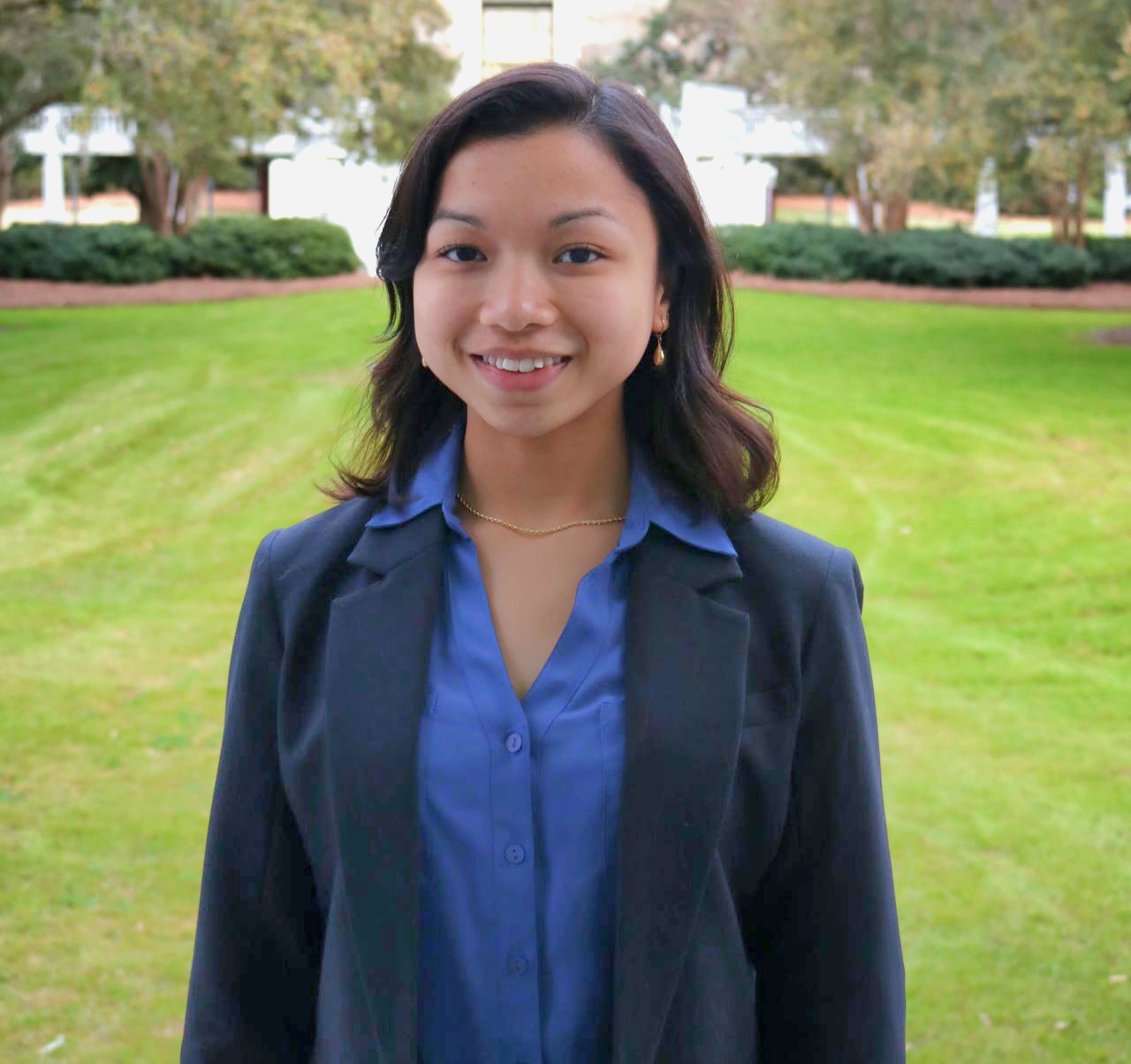
BIO
My name is Savannah Seger. I’m a freshman finance major on the pre-law track with the intention of double majoring in risk management. I was born and raised in Lakeland, Florida. From a young age, I have always had a deep appreciation for learning and research. This early curiosity laid the foundation for my lifelong pursuit of learning about the inner workings of everything around me. My dream is to become a corporate lawyer, but for now, I can settle for being a student. Outside of academics, I can often be found drawing, hanging out with friends, dancing, volunteering, working out, tinkering, or perusing Google for the latest trends or advancements. I am a member of Women in Business, Phi Alpha Delta, Food Recovery Network, and I am a desk assistant for the College of Business Dean’s Office. I am excited to see where my aspirations take me and look forward to positively impacting my community and chosen industry.
Teaching Personal Finance Skills to Young Adults with Intellectual and Developmental Disabilities
Authors: Savannah Seger, Deidre GilleyStudent Major: Finance
Mentor: Deidre Gilley
Mentor's Department: College of Education Mentor's College: Florida State University Co-Presenters:
Abstract
Research deems modified schema-based instruction (MSBI) as an evidence-based instructional strategy for teaching mathematical problem-solving. Research has narrowly evaluated MSBI when delivered by natural interventionists (i.e., teachers, paraprofessionals, etc.). To fill this area of need, this study examined the effects of teacher- and paraprofessional-delivered MSBI on teaching personal finance problem-solving to young adults with IDD in a small group setting. Using a mixed-methods, single-case experimental design, the study aimed to evaluate “under what conditions” MSBI “works”. The findings of this study indicated a functional relation between personal finance skills and teacher- and paraprofessional-delivered MSBI. Both interventionists were able to instruct with exemplary procedural fidelity and all participants demonstrated growth and sustained progress, further supporting MSBI implementation in small learning environments.
Keywords: Personal Finance, Education, Psycology, MSBI, IDD
24th annual Undergraduate Research Symposium, April 3, 2024
Patrick Tootle Poster Session 3: 1:30 pm - 2:30 pm/351
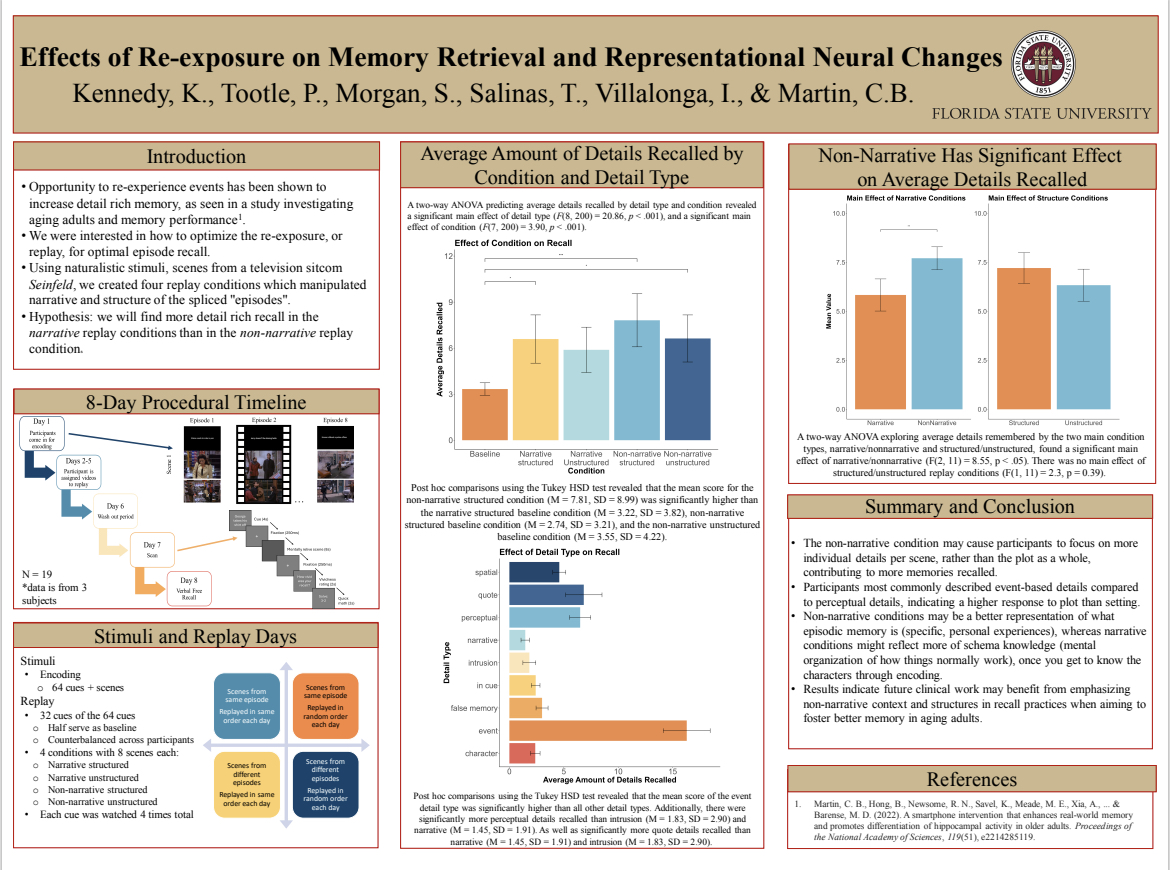
BIO
Hello! My name is Patrick Tootle and I am undergraduate student here at FSU, working on my major in psychology and minor in women’s studies. My research interests include OCD, cognitive neuroscience and clinical research pertaining to sexual and gender minorities.
Effects of Re-exposure on Memory Retrieval and Representational Neural Changes
Authors: Patrick Tootle, Dr. Chris B. MartinStudent Major: Psychology
Mentor: Dr. Chris B. Martin
Mentor's Department: Psychology Mentor's College: Arts and Sciences Co-Presenters: Kelly Kennedy
Abstract
The opportunity to re-experience an event has been shown to increase detail rich memory for the event, as seen in a study investigating aging adults and memory performance. However, the question remains as to how to best optimize the re-exposure to the event. Using naturalistic stimuli, scenes from the TV show Seinfeld, we created four “replay” conditions. We used functional magnetic resonance imaging (fMRI) to determine how replay type influences representational change in the brain. Participants encoded scenes from the show that were spliced together to fit our manipulations of interest. Then, they replayed these scenes over four days. The experiment was a total of eight days, which concluded with an fMRI scanning task and a verbal recall session on the final two days. We hypothesized that scenes played together in the same order, structured replay type, will facilitate representational change in the direction of integration in the hippocampus, while scenes that are played in a random order, unstructured replay type, will facilitate representational change in the direction of separation in the hippocampus. Representational similarity analyses will be conducted to investigate this hypothesis. We will also be conducting behavioral analyses on the participants’ recall transcripts. We anticipate that we will find more detail rich recall in the narrative replay type than in the non-narrative replay type.
Keywords: memory, retrieval, narrative
24th annual Undergraduate Research Symposium, April 3, 2024
John Askew Poster Session 1: 9:30 am - 10:30 am /175
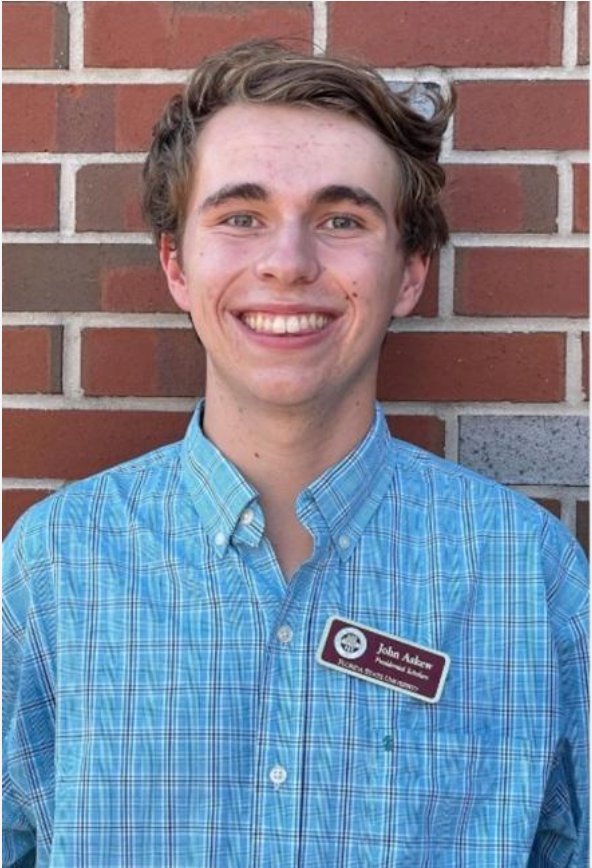
BIO
John is a Junior from Salt Lake City, Utah. His research interests center on the intersection between social and clinical psychology, with an emphasis on how social systems and group dynamics impact mental health. He plans to pursue a PhD in Clinical Psychology.
Invalidation as Trauma?: Post-traumatic Cognitions Relate to Invalidation and Suicidality
Authors: John Askew, Dr. Thomas JoinerStudent Major: Psychology
Mentor: Dr. Thomas Joiner
Mentor's Department: Psychology Mentor's College: Arts and Sciences Co-Presenters:
Abstract
Theoretical and empirical work suggests that emotional invalidation is correlated with suicidal ideation (SI) through post-traumatic cognitions (PTC). To discern this potential relationship, an indirect effects model was estimated to test whether PTCs accounted for the relationship between emotional invalidation and SI. A combined sample of adults (n = 460) with at least one minoritized identity (75.9% cis-gendered women, 75.7% people of color, 43.9% non-heterosexual, 3.9% transgender, and 17.6% disability-identifying) was collected across several waves of recruitment from a large university in the southeastern U.S.
A structural equation indirect effects model was estimated using robust maximum likelihood with the following three parallel mediators to examine differential effects across PTC types: Negative Cognitions About Self (NCAS), Negative Cognitions About the World (NCAW), and Self-Blame (SB). The estimated model fit well (CFI = .946, TLI = .937, RMSEA = .053). Results indicated that NCAS partially accounted for the relationship between perceived invalidation and SI (p = .001) while NCAW and SB did not (p’s > .05). Findings indicate PTCs, and in particular NCAS, may serve an important role in the relationship between invalidation and SI. Further research and clinical work that focuses on mitigating the impact of negative self-cognitions may benefit suicide prevention efforts targeting diverse populations, including trauma-focused evidence-based therapies that address NCAS.
Keywords: Suicide, Minority Stress, Invalidation, Psychology, Clinical
24th annual Undergraduate Research Symposium, April 3, 2024
Hannah Burke Poster Session 1: 9:30 am - 10:30 am /395
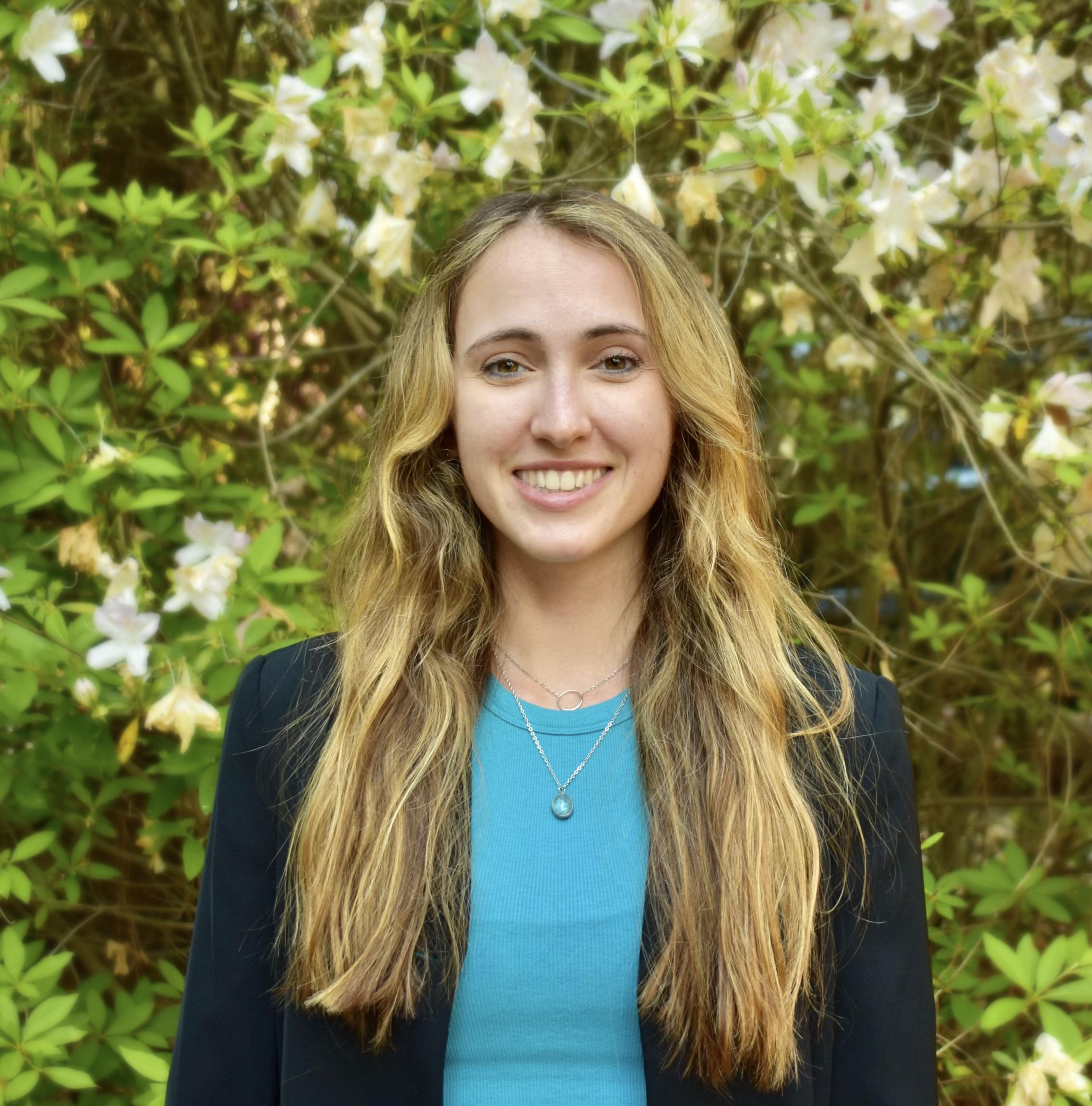
BIO
I am a fourth year undergraduate student from Ormond Beach, Florida. At Florida State, I am involved in the Lemmon and Underwood/Inouye lab. The poster I am presenting is the culmination of my DIS project in the Lemmon Lab, working with graduate student Courtney Whitcher. After graduating this May, I will be moving west and taking a gap year to work seasonal research and field technician positions while applying for PhD programs to start in 2025. I am working toward a career in conservation biology and am very passionate about research topics which will aid in future land management decisions.
Finding Fluorescence: utilizing community science to document novel biofluorescence occurrences and encourage community engagement in science
Authors: Hannah Burke, Dr. Courtney WhitcherStudent Major: Biological Science
Mentor: Dr. Courtney Whitcher
Mentor's Department: Biological Sciences Mentor's College: Florida State University Co-Presenters:
Abstract
Biofluorescence, observed in living organisms, involves the absorption of light at one wavelength and re-emission at a longer wavelength due to fluorophores in specialized cells or structures. While extensively studied in marine organisms, attention has shifted to exploring biofluorescence in terrestrial organisms, revealing its ecological role in reproduction, camouflage, communication, and prey attraction across phyla. Community science databases have become valuable tools in recent years, engaging the public in data collection, fostering scientific discovery, and strengthening the science-society connection. This study introduces Finding Fluorescence, a community science website established in 2020 to gather public observations of biofluorescent organisms. The study presents at least 16 novel biofluorescence accounts, spanning five phyla, 15 families, and 16 species. The observations collected from Finding Fluorescence contribute to our understanding of fluorescence in organisms and provide insight into possible ecological functions. We emphasize the importance of community engagement in scientific exploration and encourage future studies to incorporate such aspects into their research.
Keywords: Biofluorescence, fluorescence, community science, ecology
24th annual Undergraduate Research Symposium, April 3, 2024
Devon Carr Poster Session 1: 9:30 am - 10:30 am /19
BIO
Originally from Tampa, FL, I am a Junior Cyber-Criminology student at Florida State University. I am strongly interested in government, juvenile justice, public policy, politics and lobbying. I am currently studying for my LSAT exams with hopes of attending law school in Fall 2025.
North Carolina Teen Court and Recidivism: The Team Process
Authors: Devon Carr, Dr. Alexandra CockerhamStudent Major: Cyber-Criminology
Mentor: Dr. Alexandra Cockerham
Mentor's Department: Interdisciplinary Social Science Program Mentor's College: College of Social Sciences and Public Policy Co-Presenters:
Abstract
Teen Court programs are diversion programs that serve as an alternative to processing juveniles through the traditional justice system. They are implemented around the country in hopes of reducing recidivism rates for juveniles. Juveniles can be referred to the Teen Court program through a juvenile court counselor, school administrators, law enforcement, or other members of the local community. This research examines whether the teen court in North Carolina reduces juvenile recidivism and provides descriptive information about the teen court policies and procedures across counties.
- In North Carolina, 68 counties have Teen Court programs while 32 counties do not.
- This project is enabled by the North Carolina Division of Juvenile Justice and Delinquency Prevention and the North Carolina Office of Strategic Partnerships.
- This project examines the Teen Court process through three different methods: surveys, site visits, and statistical analysis.
This research was enabled through teamwork and collaboration across the research team and a team of state workers in the North Carolina justice system and each member of the team worked together to achieve a better understanding of the research question.
Keywords: Teen Court, Juvenile Justice, North Carolina
24th annual Undergraduate Research Symposium, April 3, 2024
Savanah Rodriguez Poster Session 3: 1:30 pm - 2:30 pm/156
BIO
I am a second year student at Florida State University. I was born and raised in Miami, FL. I took interest in this research project because I have always wanted to work/help children in any capacity. Being bilingual myself, I especially took interest in advocating and helping children that may need the extra help and contribute to research being done to improve quality of life. In my professional career I hope to work with children. I am interesting in careers like Speech language pathology, behavioral analysts, and/or therapy. I look forward to continuing my academic career and make strides in research.
MAR-P: Morphological Analysis Pathway to Reading
Authors: Savanah Rodriguez, Dr. Carla WoodStudent Major: Human Development and Family Sciences & Psychology
Mentor: Dr. Carla Wood
Mentor's Department: School of Communication Science and Disorders Mentor's College: School of Communication Science and Disorders Co-Presenters: Marissa Young
Abstract
MAR-P aims to improve literacy instructions for MLs with and at risk for disabilities. Furthermore, improves engagement in literacy instructions for MLs with
and at risk for disabilities. This study is aimed for elementary school classrooms (3rd-5th grade) which were inclusive of children from diverse abilities and linguistic backgrounds. We will be implementing adaptive practices and online modules to elementary students and recording their engagement, minutes of ELA instruction, number of lessons, modules, and discussions completed, and how much time was spent on each lesson. Overall, we aspire to observe an improvement in reading comprehension and general vocabulary
Keywords: MAP-R, Language, Bilingual, Literacy
24th annual Undergraduate Research Symposium, April 3, 2024
Madeline McNally Poster Session 3: 1:30 pm - 2:30 pm /339
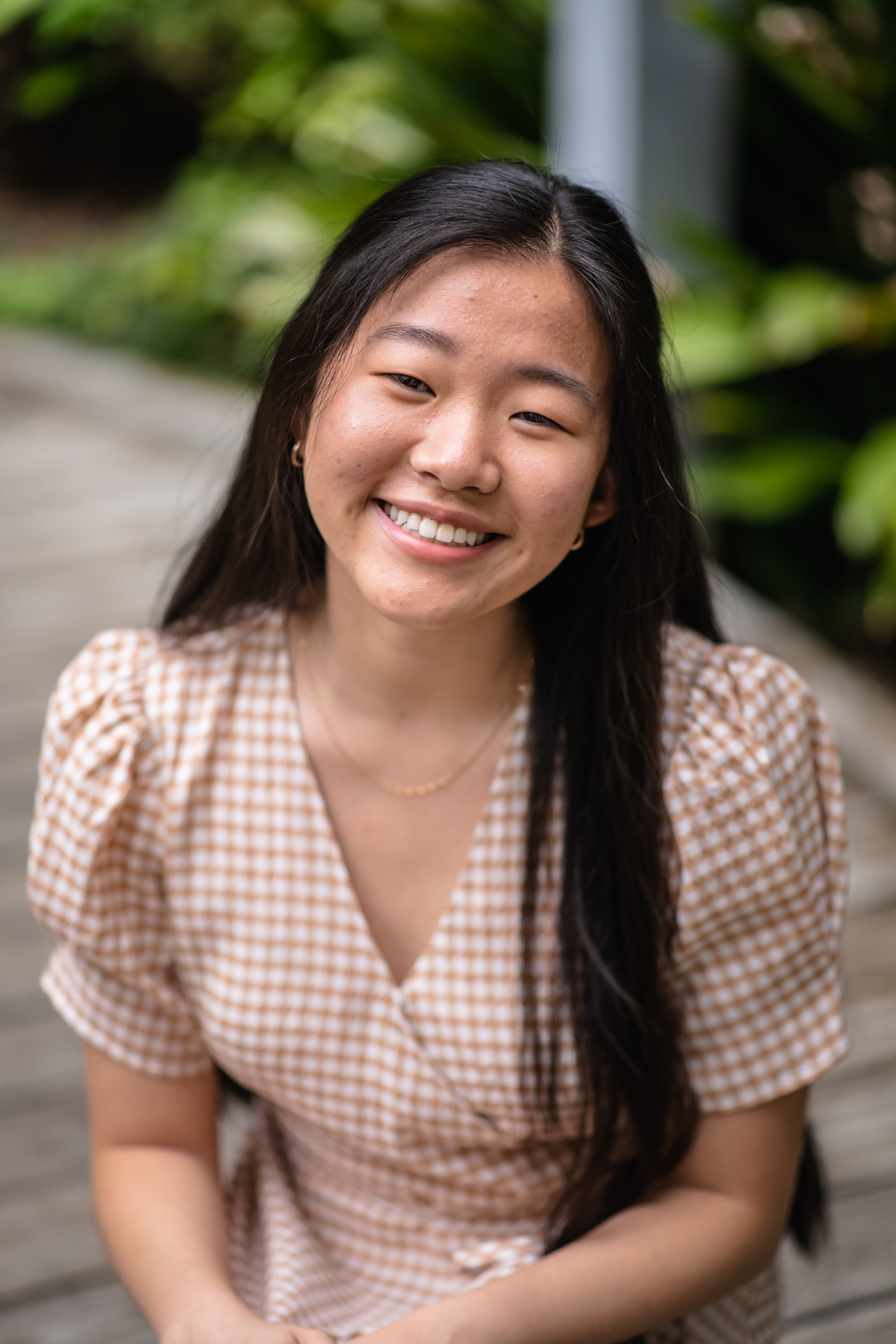
BIO
I am a current sophomore majoring in Cell and Molecular Neuroscience. As a UROP student, my research project was conducted in the Hermiller Memory Lab. My future career aspirations include attending medical school and specializing in neurology.
Testing network distinctions between face processing and memory
Authors: Madeline McNally, Molly S. HermillerStudent Major: Cell and Molecular Neuroscience
Mentor: Molly S. Hermiller
Mentor's Department: Department of Psychology Mentor's College: College of Arts and Sciences Co-Presenters:
Abstract
Episodic memory refers to the ability to form and recall memories, including contextual/spatial details specific to daily events. The hippocampal-cortical network (HCN) is a series of brain regions that interact with the hippocampus to support episodic memory processes. Regions in the HCN medial temporal lobe overlap with the face-processing network (FPN), involved with perceiving/recognizing faces. The extent to which the FPN and HCN are distinct during face perception versus episodic memory encoding, despite overlapping hippocampal and medial temporal lobe regions, is unknown. Of note, are the different cortical areas involved with each network, with left parietal cortex engaged with the HCN and right superior temporal sulcus (rSTS) involved specifically with face-processing. In this study, we use noninvasive brain stimulation (transcranial magnetic stimulation, TMS) to selectively modulate the HCN (left parietal cortex) or FPN (rSTS) to causally test their roles in memory versus face perception. Our task includes a perceptual judgment phase (house/face stimuli) and encoding phase (house/face stimuli). TMS is delivered in a trial-specific manner to influence either perceptual judgements or memory formation. We hypothesize that TMS to the rSTS will selectively influence perceptual judgments of the face but not house stimuli, as the rSTS has been shown to be specifically involved with face perception. We expect that TMS to the HCN will enhance memory for both faces and houses, as the memory network is not stimuli-specific. Results from this study will increase our understanding of the roles the HCN and FPN have in supporting distinct cognitive processes.
Keywords: Neuroscience, Episodic Memory, Face Processing, Perception, TMS
24th annual Undergraduate Research Symposium, April 3, 2024
Valerie Johnstone Poster Session 5: 4:00 pm - 5:00 pm/59
BIO
I am a psychology and Japanese major from Tallahassee. I am planning on pursuing a PhD in clinical psychology and am interested in research related to anxiety and obsessive-compulsive disorders. I am currently working in the Patrick lab in the psychology department where I assist with EEG research.
Link between Threat Sensitivity and Reward Activation: Relations with Alcohol Sensitivity
Authors: Valerie Johnstone, Alexander KallenStudent Major: Psychology and Japanese
Mentor: Alexander Kallen
Mentor's Department: Psychology Mentor's College: Arts and Sciences Co-Presenters:
Abstract
Individuals with low sensitivity to alcohol’s effects have greater risk for harmful alcohol use. Low sensitivity to alcohol is also linked with enhanced brain responses to alcohol cues, suggesting increased motivational value of such stimuli. However, the relation between alcohol sensitivity and neural responses to reward feedback, such as the Reward Positivity (RewP), is untested. RewP magnitudes have shown inconsistent associations with drinking severity, and one’s alcohol sensitivity level may clarify these prior mixed findings. Another related factor, variations in threat sensitivity or fearfulness, correlates positively with RewP and alcohol use levels. In the current study, we aim to clarify the connections between self-reported threat sensitivity and RewP elicited during a simple gambling task, among college students with low (N = 26) versus high (N = 30) alcohol sensitivity. Analyses showed no significant group differences in low and high alcohol sensitive individuals in relation to RewP amplitudes, nor did threat sensitivity moderate the RewP difference. However, a sample size of only 56 individuals may not have been large enough to accurately display the effect of these variables on reward reactivity. Additionally, the current lack of findings implies that other risk factors may alter the connection between alcohol and monetary reward sensitivity. Future studies should aim to expand this sample size as well as incorporate additional measures of symptoms that increase an individual’s susceptibility to harmful alcohol use. Researchers should persist in examining the connections between alcohol and reward sensitivity, alongside its implications for substance use disorders.
Keywords: "Alcohol" "Reward" "Threat Sensitivity"
24th annual Undergraduate Research Symposium, April 3, 2024
Joseph Ciancio Poster Session 1: 9:30 am - 10:30 am /93
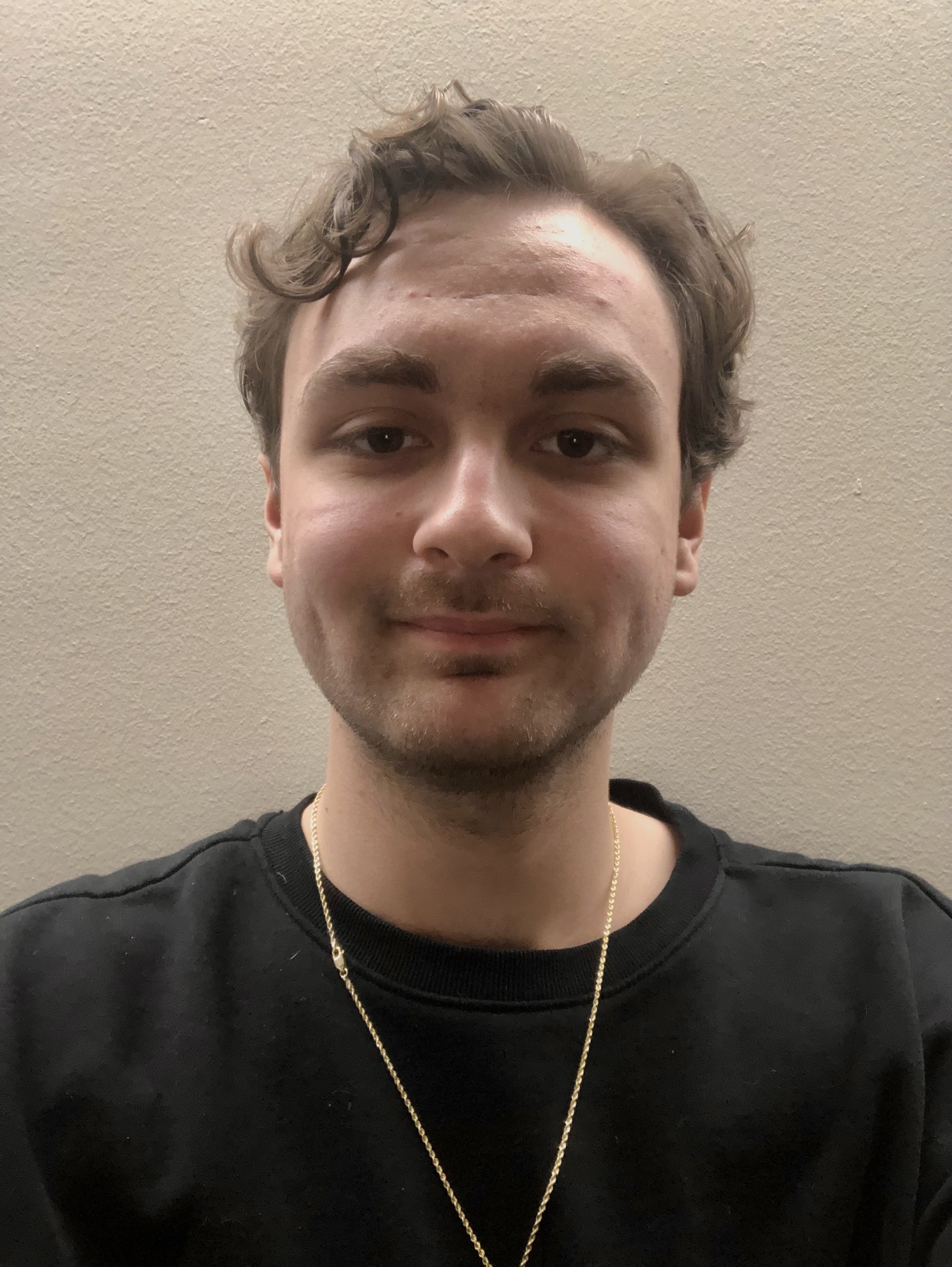
BIO
Following graduation, I plan on perusing clinical psychology at the graduate level with an explicit interest in suicidality and related mood disorders. I hope to research causal models of suicide and evidence based interventions as well as provide care directly through counseling services.
Examination of the Protective Effects of Religious Affiliation on VR Suicide Behaviors
Authors: Joseph Ciancio, Esther ParkStudent Major: Psychology
Mentor: Esther Park
Mentor's Department: Psychology Mentor's College: College of Arts and Sciences Co-Presenters:
Abstract
Previous studies have suggested religion may protect against suicidality, possibly due to its influence on cognitive aspects, such as preserving a sense of hope and belonging, and social aspects, such as community based coping. However, methodological constraints, including the use of repetitive protocols and non-diverse samples, have left a significant gap in our understanding. The current study utilizes the Virtual Reality paradigm to explore the relationship between religious status and both prior suicidality and VR suicide decisions. Contrary to our hypotheses, analysis of 188 participants across two VR studies found no significant correlation between religious status and history of suicidal ideation (β = .482, p = .356), planning a suicide attempt (β = .959, p = .369), or making an attempt (β = .959, p = .369). Similarly, religious status did not predict the number of VR suicide attempts (β = .515, x2 = 1.264, p = .261), potentially suggesting no protective influence of religious status on suicidality. Our findings conflict with the larger body of previous studies suggesting a need for deeper analysis of mechanistic links between religiously driven cognitions and the spectrum of suicidality.
Keywords: suicidality, technology in psychology, religion
24th annual Undergraduate Research Symposium, April 3, 2024
Dev Sangha Poster Session 1: 9:30 am - 10:30 am /115
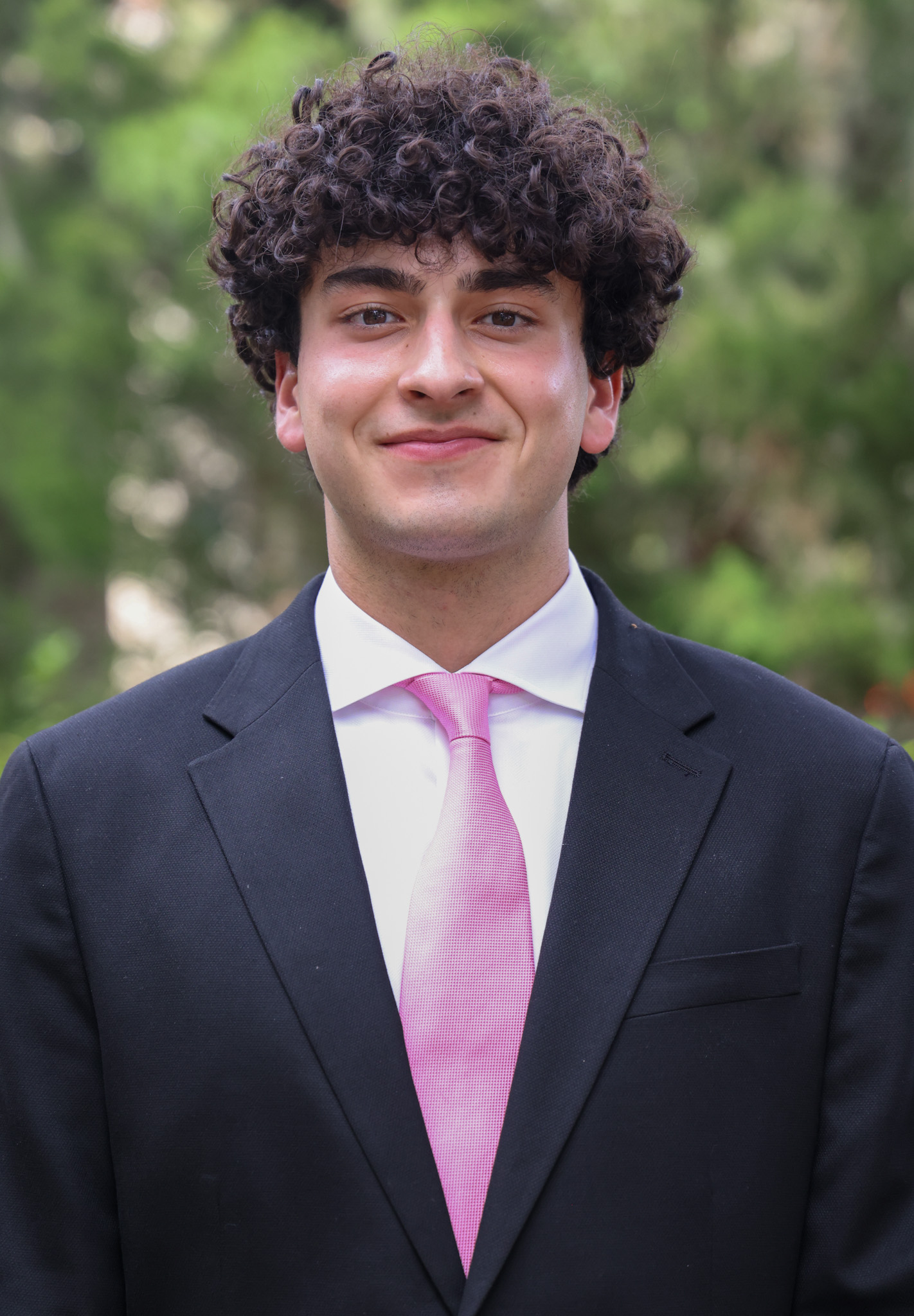
BIO
My name is Dev Sangha and I am from Jersey City, New Jersey. I have an interest in design and research. At the Solis lab, I have the opportunity to merge research with design through the making of a myocardial slice device. I would love to be a surgeon in the future.
Development of Myocardial Slices for Cardiovascular Studies
Authors: Dev Sangha, Christopher SolisStudent Major: Biological Science
Mentor: Christopher Solis
Mentor's Department: Department of Health, Nutrition, and Food Sciences Mentor's College: College of Education, Health, and Human Sciences Co-Presenters:
Abstract
Heart disease and failure remain the top causes of death in the world, even with the many new advancements in the field. Gaining a deeper understanding of the heart can prove to be beneficial for saving lives. Myocardial slices, which are cut to 1 centimeter square and 100 to 400 µ thin, are slices of living muscle tissue from the heart. For testing, the slices are cut from animal hearts. The myocardial strips are then examined, looking at the contractile function of the heart as the living slices contract and expand. A literature review identified the best-suited platform to induce mechanical stimulation onto myocardial sheets. This system is anticipated to support multi-sensory analysis of myocardial tissue response to stretch. Improvements in analyzing myocardial strips can help future heart research to minimize heart-related problems.
Keywords: heart, cardiac, myocardium
24th annual Undergraduate Research Symposium, April 3, 2024
Emma Brown Poster Session 3: 1:30 pm - 2:30 pm /267
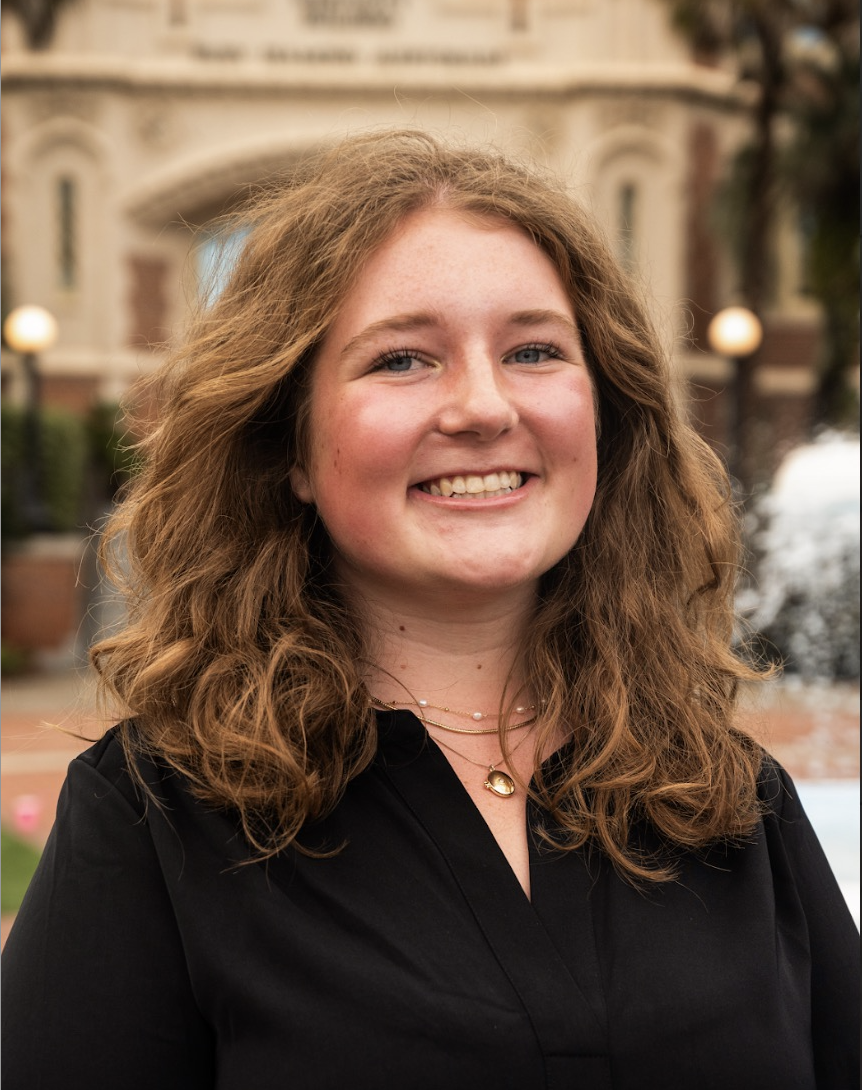
BIO
I am Emma Brown, a freshman Presidential Scholar from Baltimore, Maryland. I am pursuing a dual degree in Criminology and Middle Eastern Studies with the dreams of being a public defender. I hope to use my love of law and studying languages to help people of all backgrounds.
Developmental Pathways Explaining Repeat Victimization: The Influence of Delinquent Friendships
Authors: Emma Brown, Myunghee YouStudent Major: Criminology and Middle Eastern Studies
Mentor: Myunghee You
Mentor's Department: Criminology Mentor's College: College of Criminology and Criminal Justice Co-Presenters:
Abstract
There is a causality linking victimization and delinquent
friendships. Previous studies have argued that
victimization affects changes in deviant peer affiliations,
but the mechanisms by which victimization affects peer
associations have rarely been examined. Through a further
literature review, my study explores whether victimization
increases delinquent peer affiliations and the casual
processes involved. Additionally, this research examines, in
a more general sense, who the targets are, what risk factors
increase the risk of victimization, and even what the
negative consequences of victimization would be. Finally, I
suggest policy implications to reduce the risk of
victimization for adolescents.
Keywords: delinquent, peers, victimization


